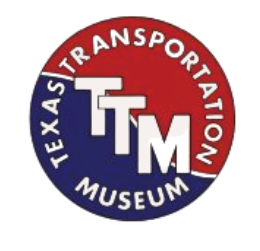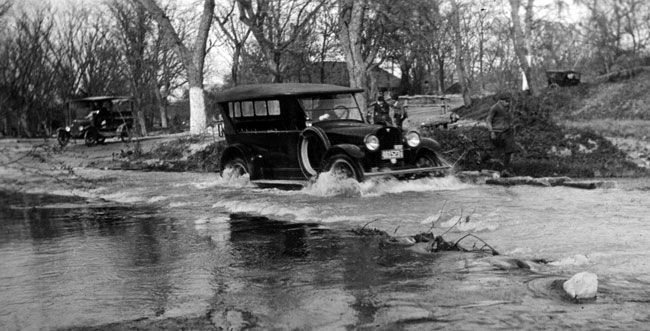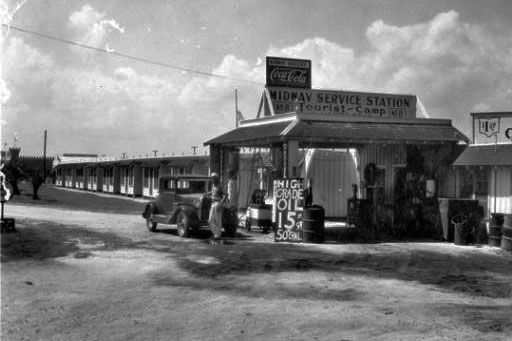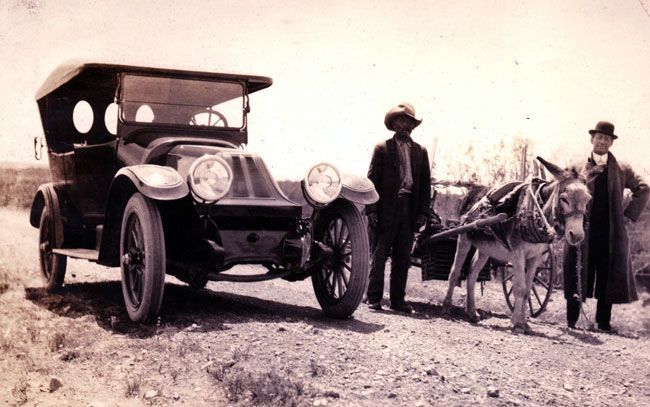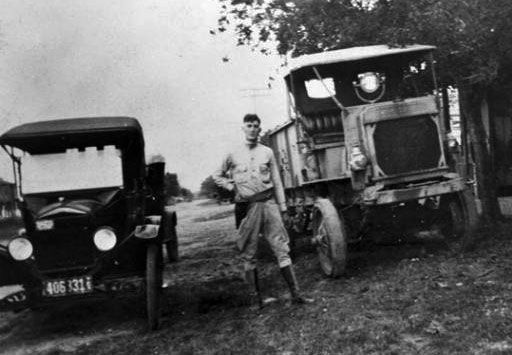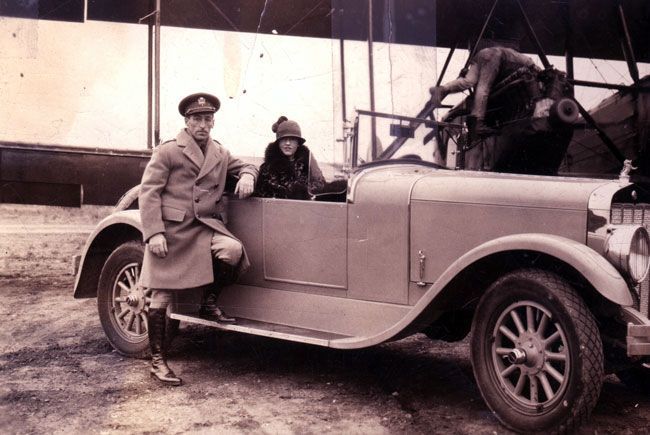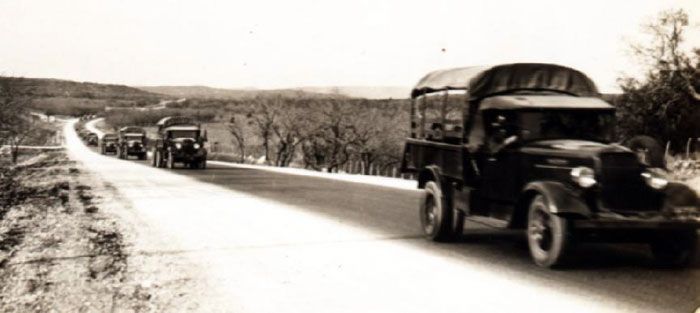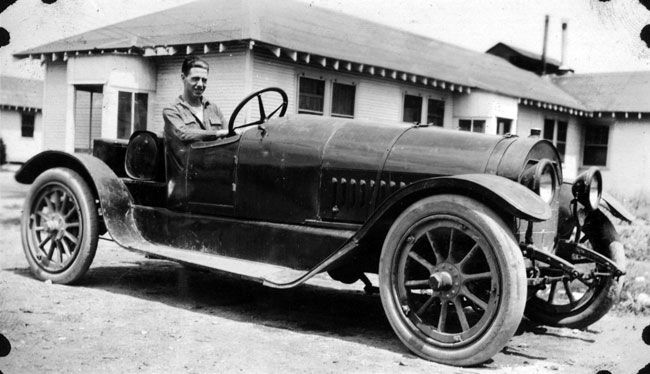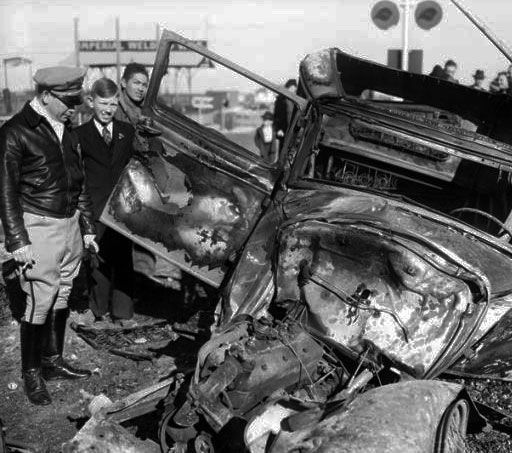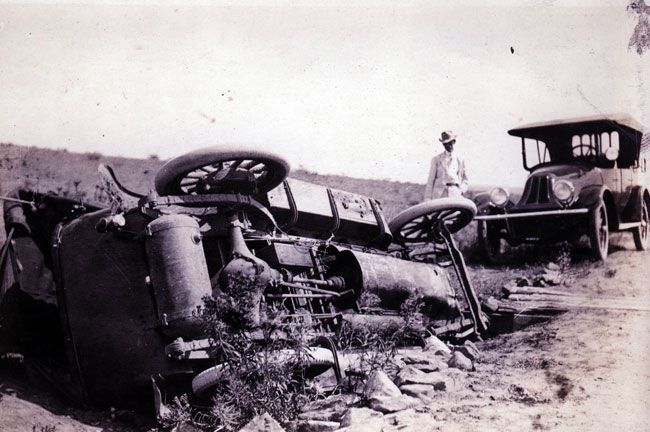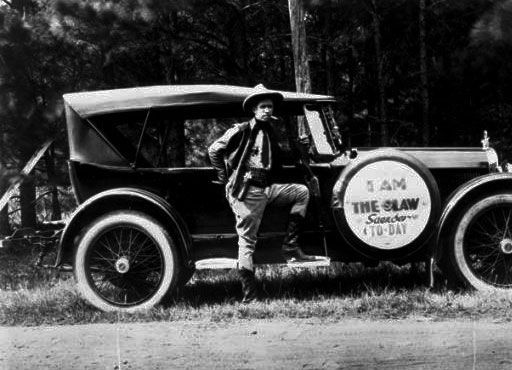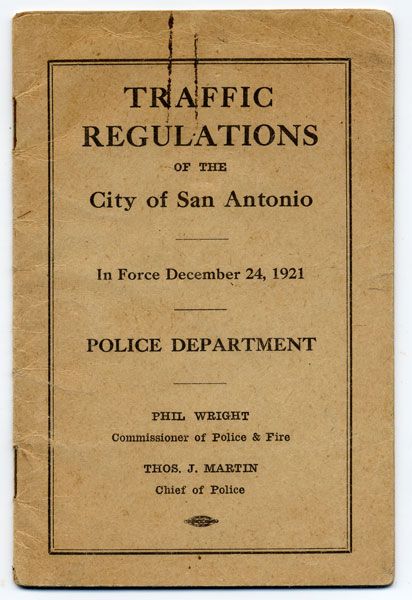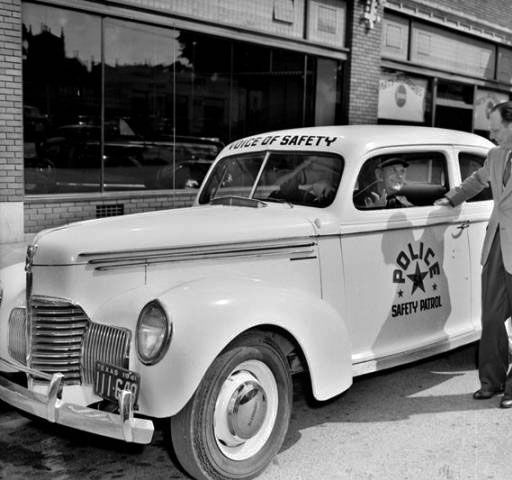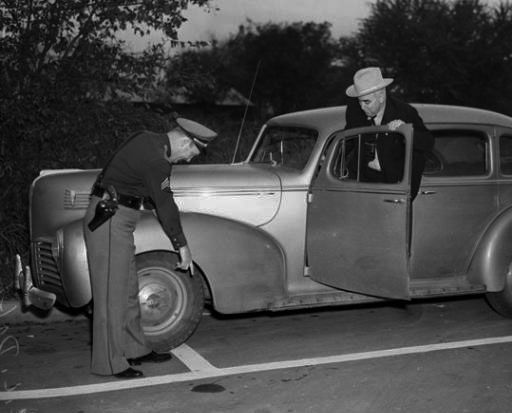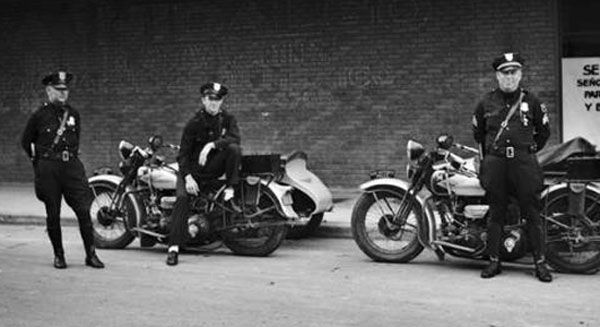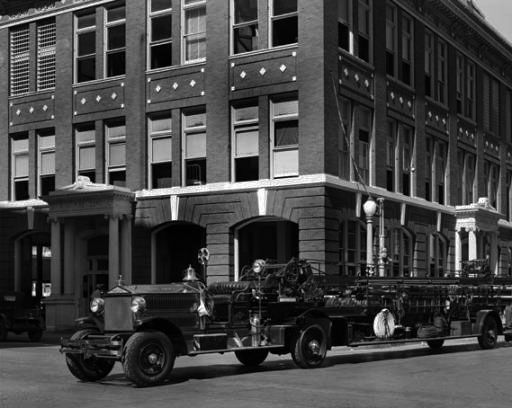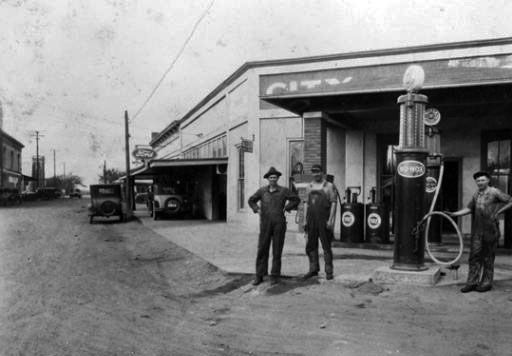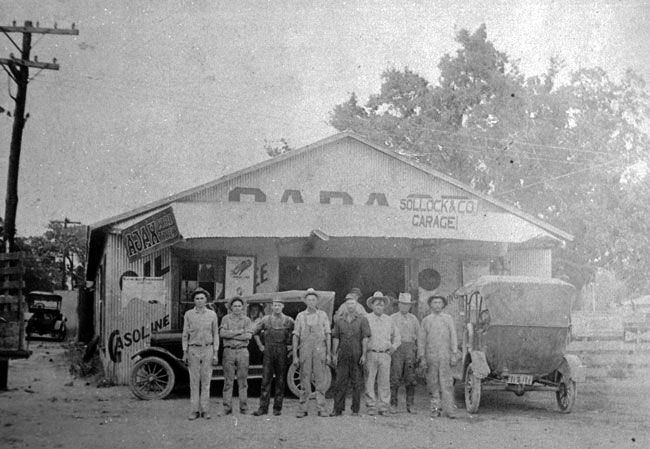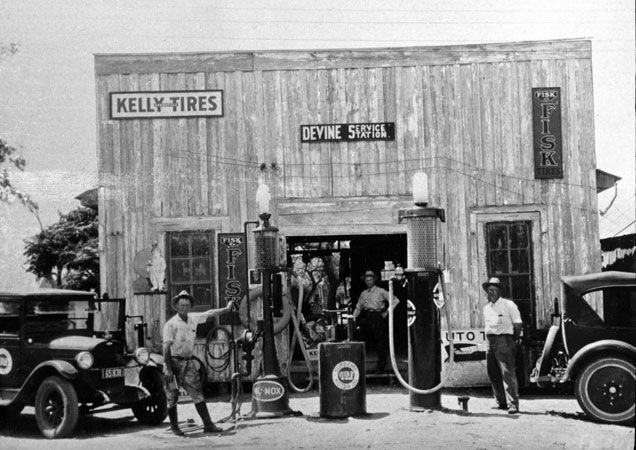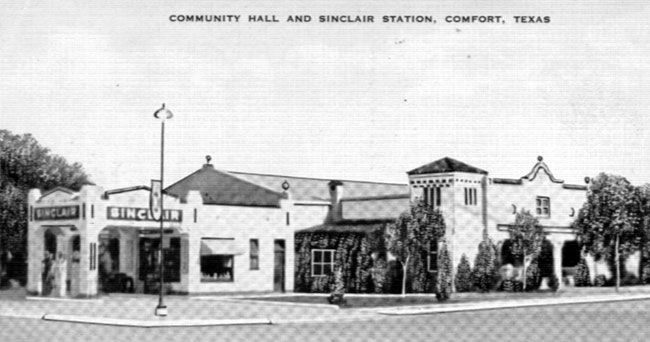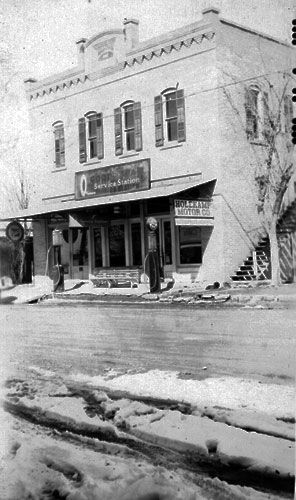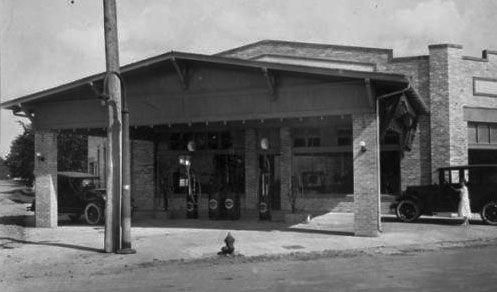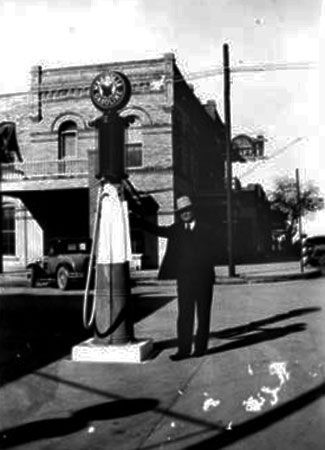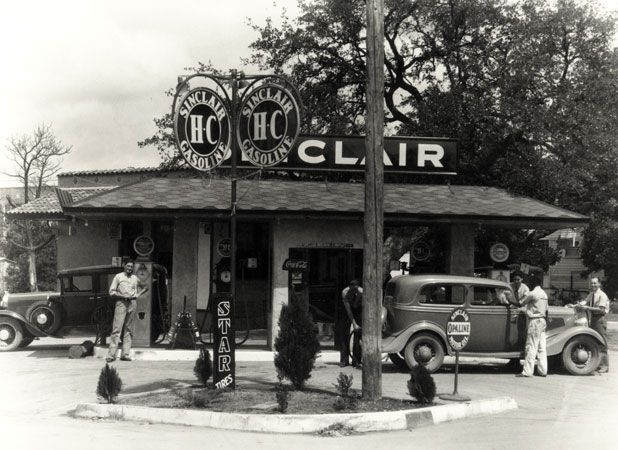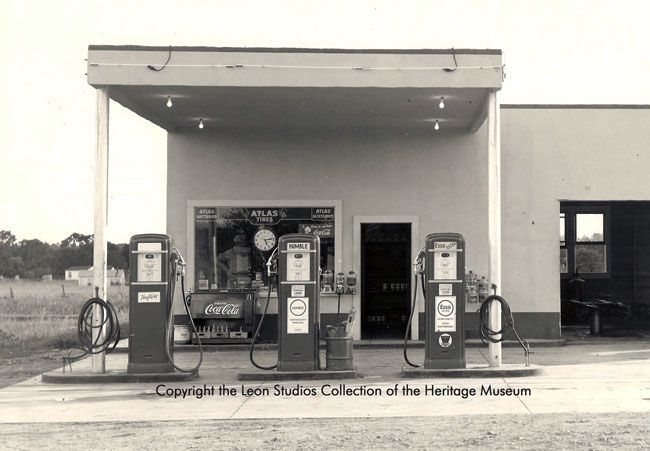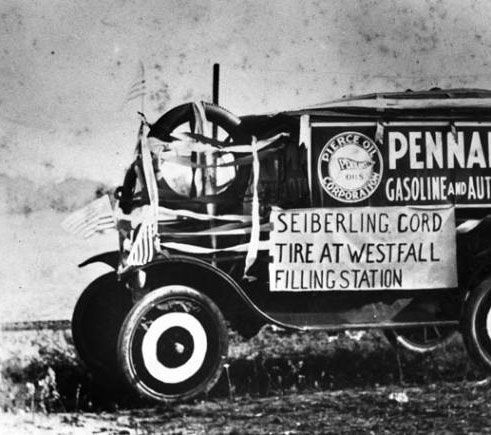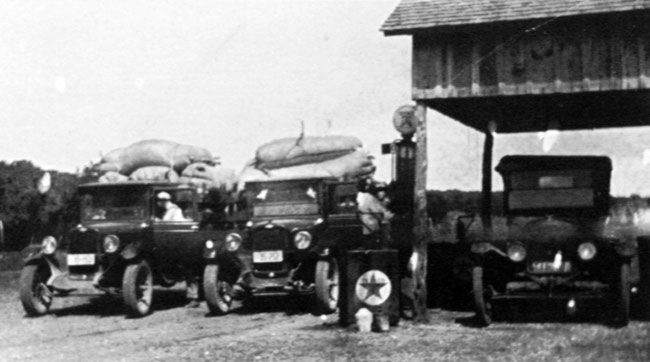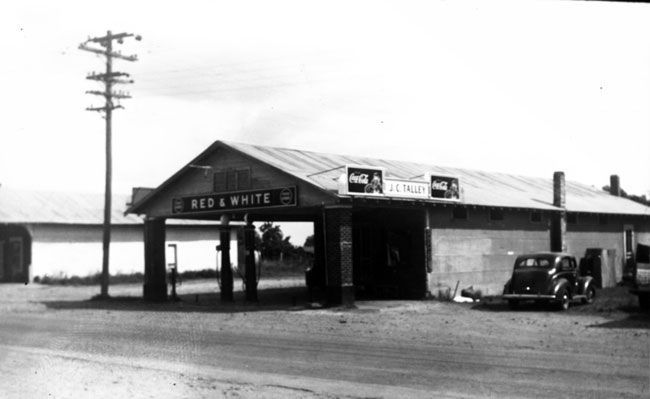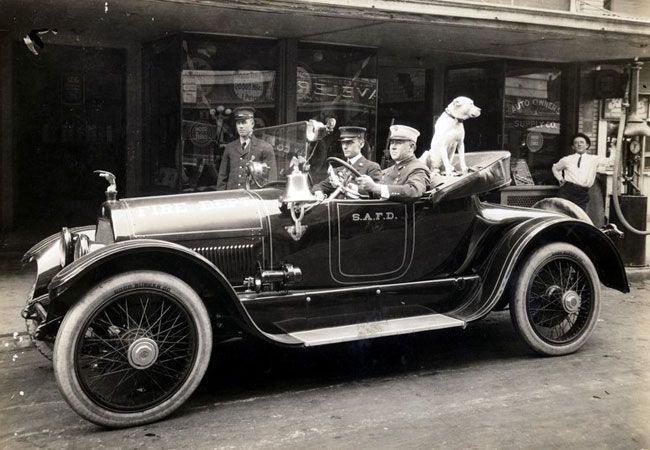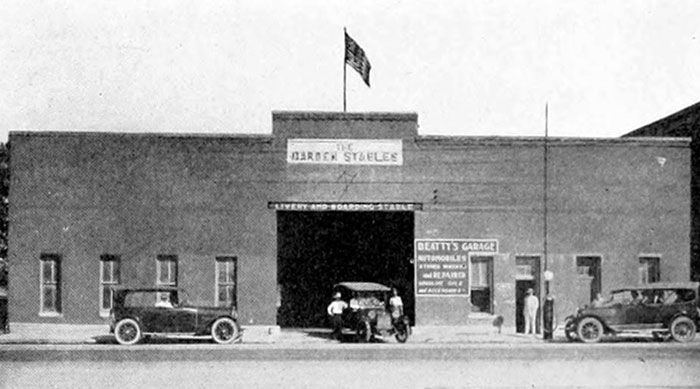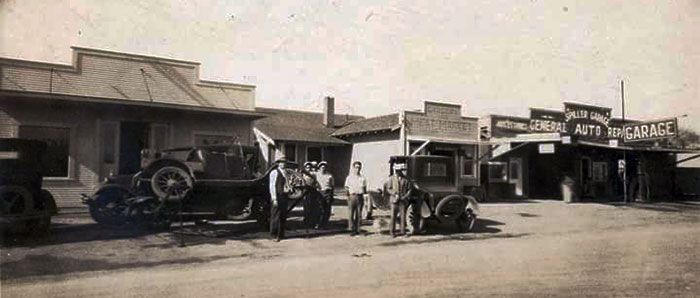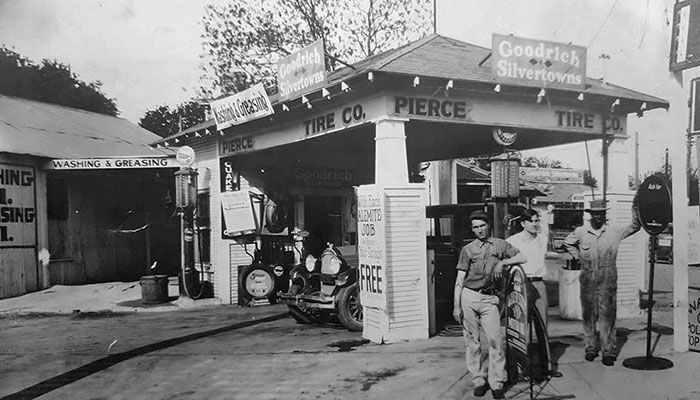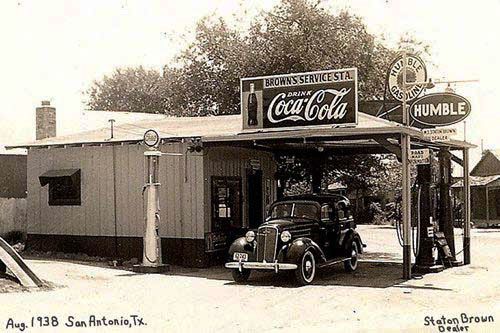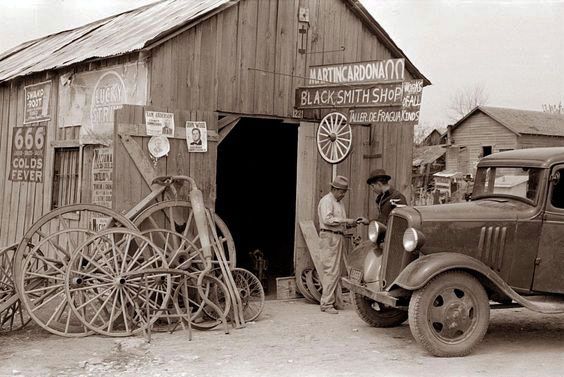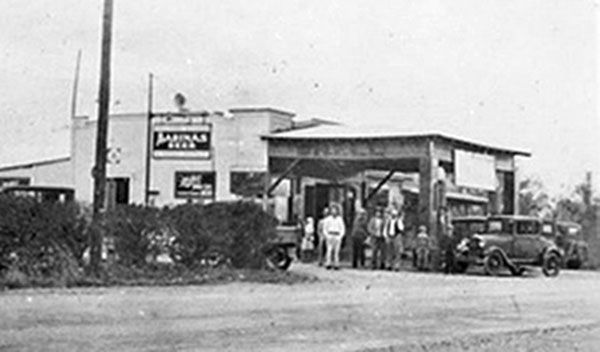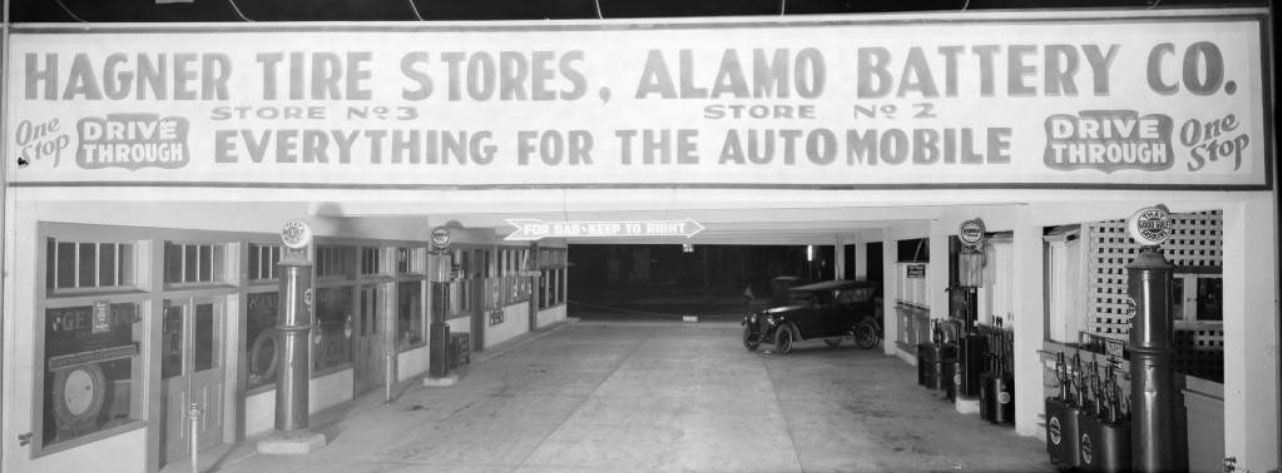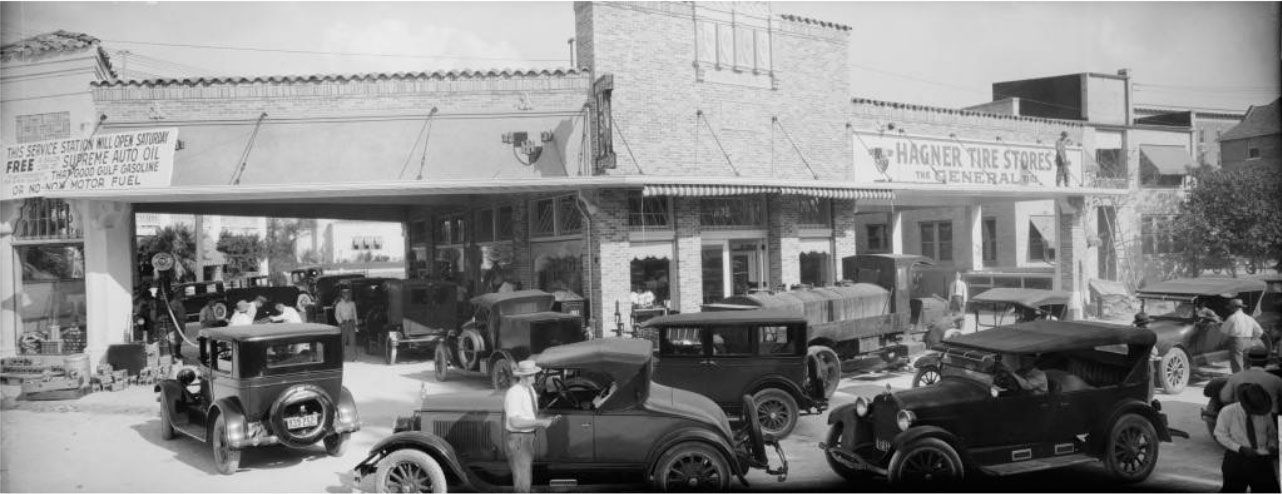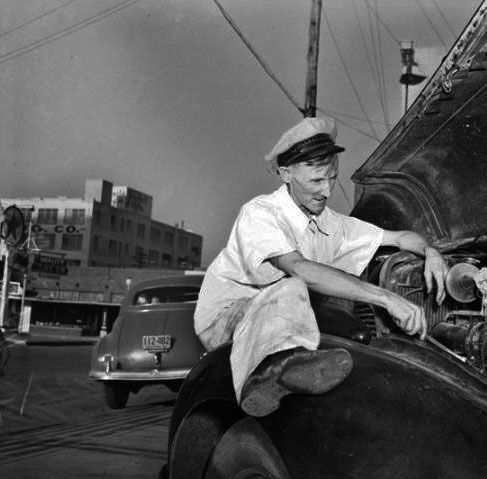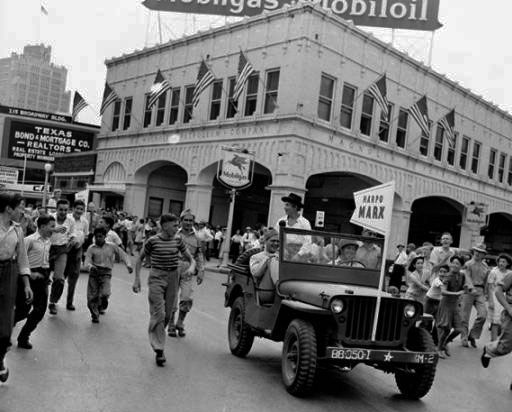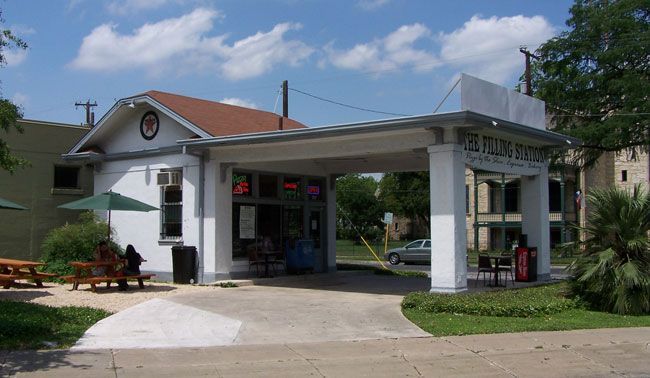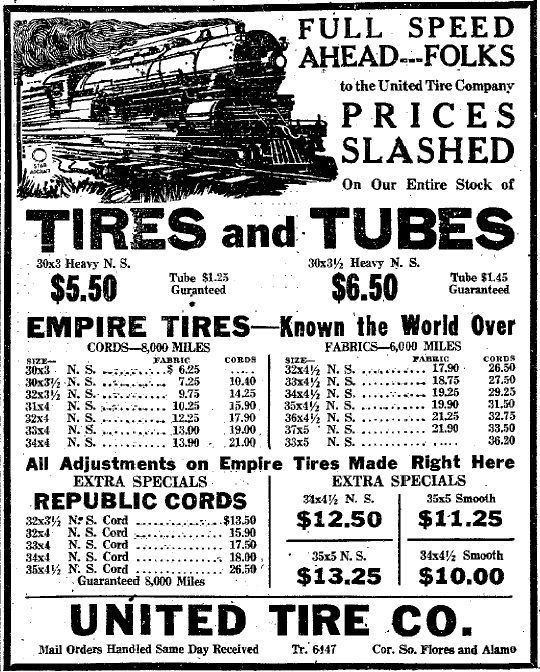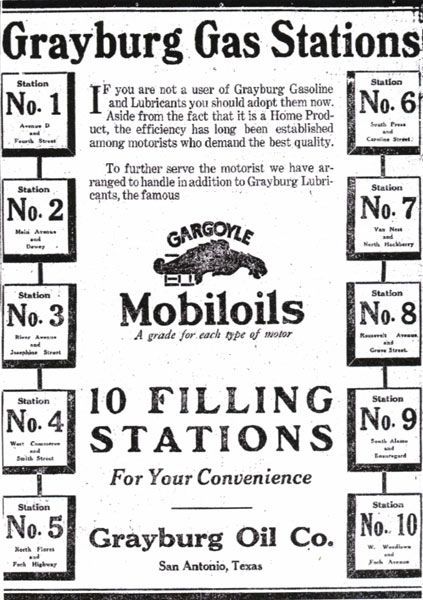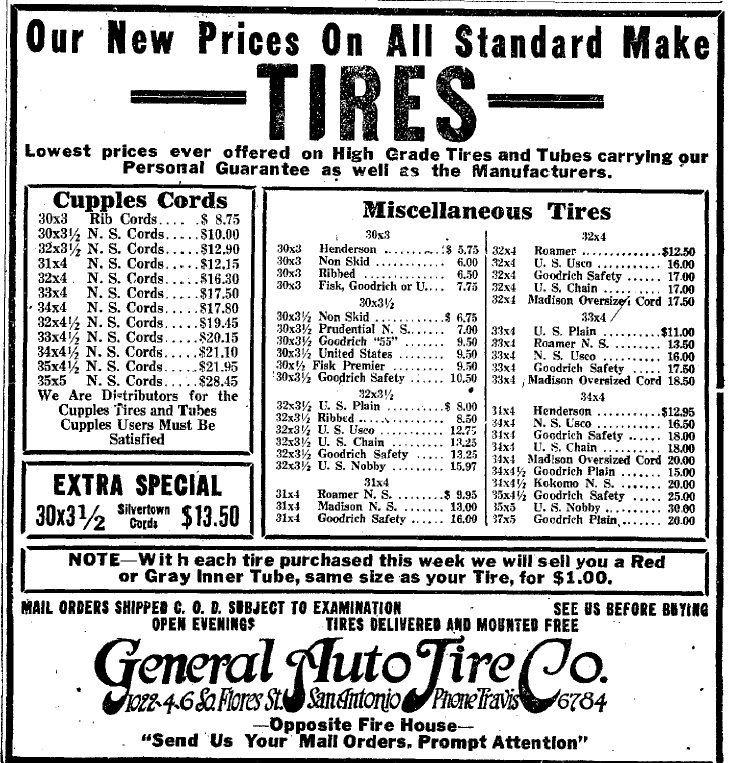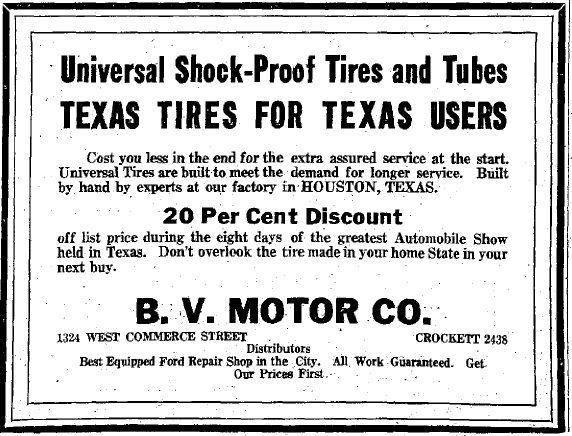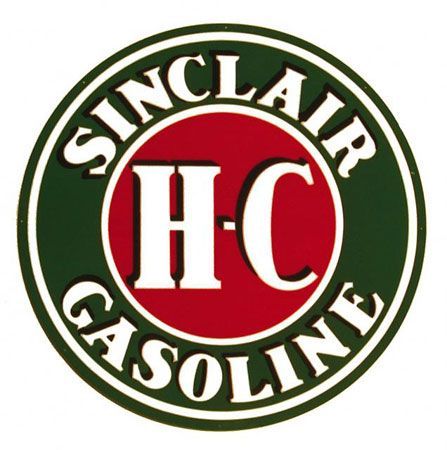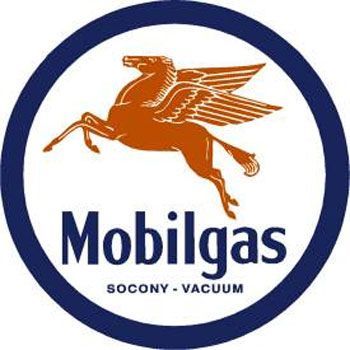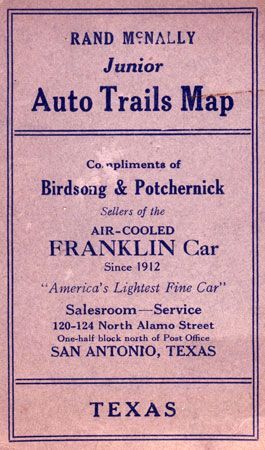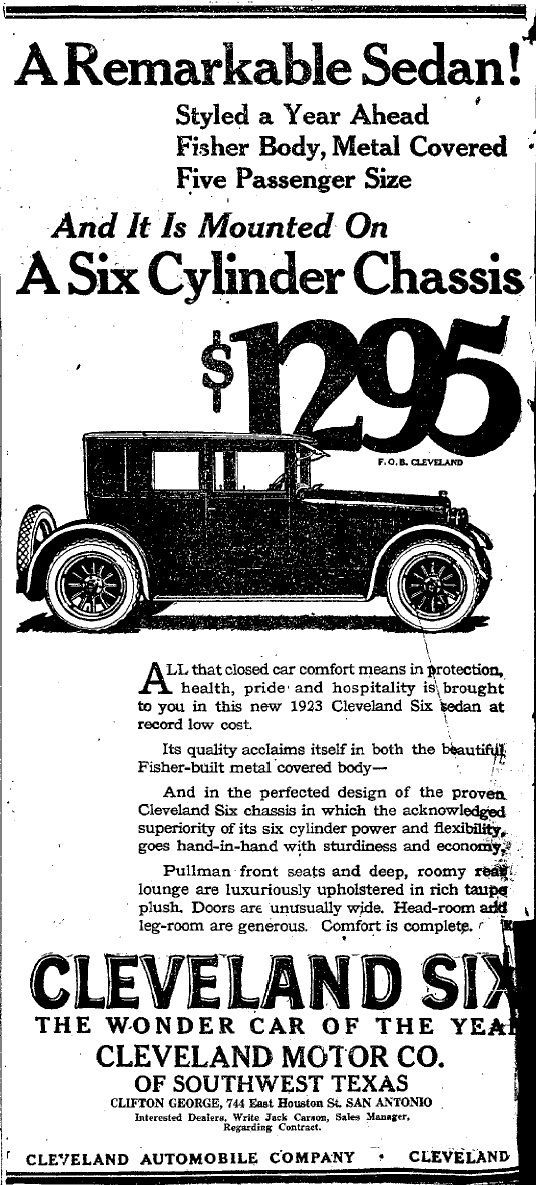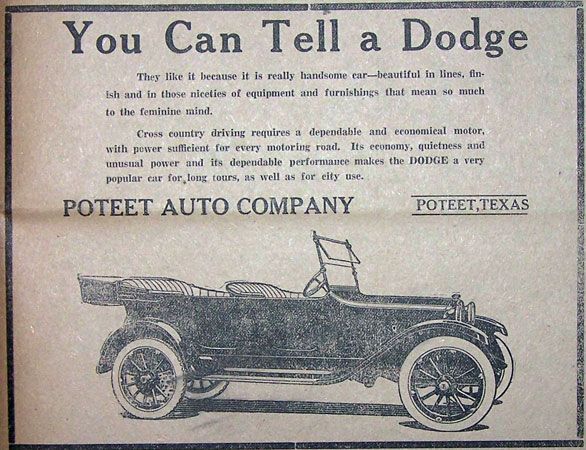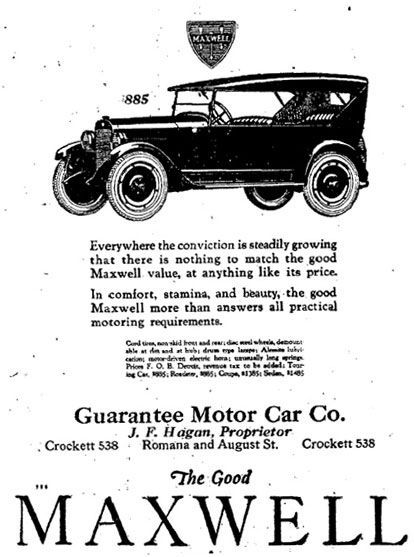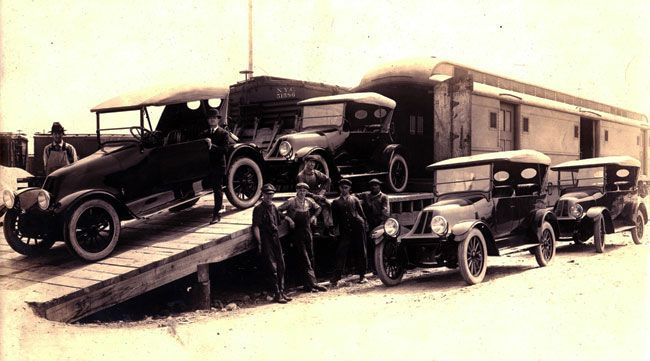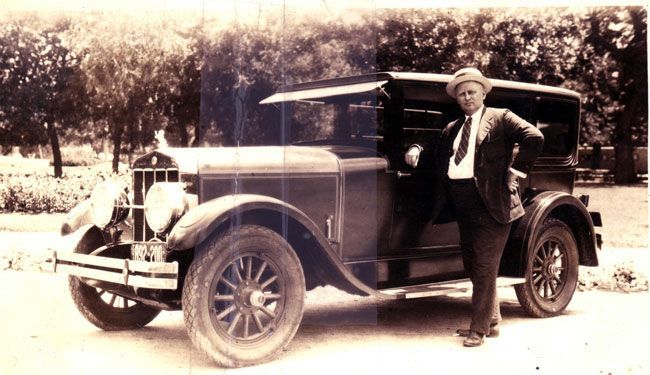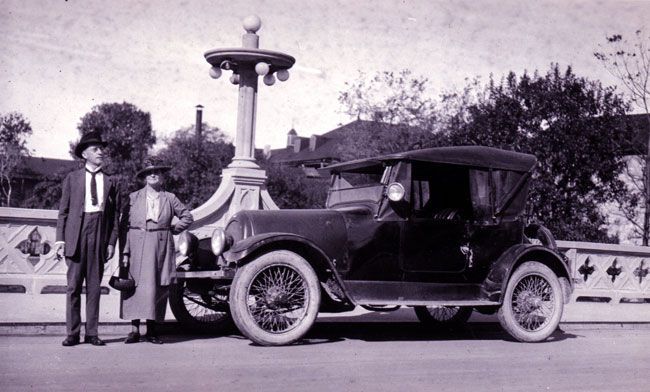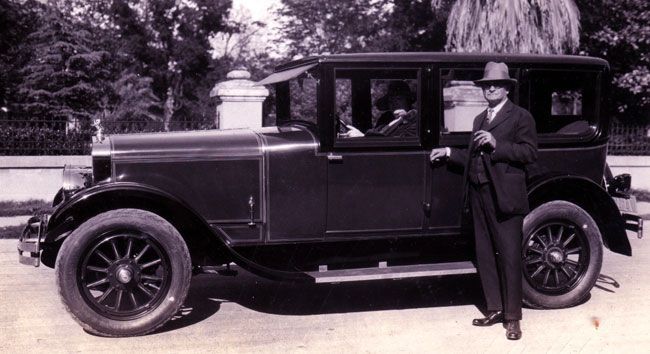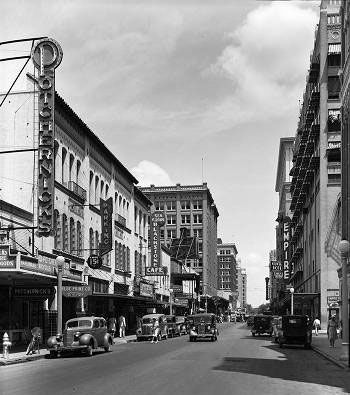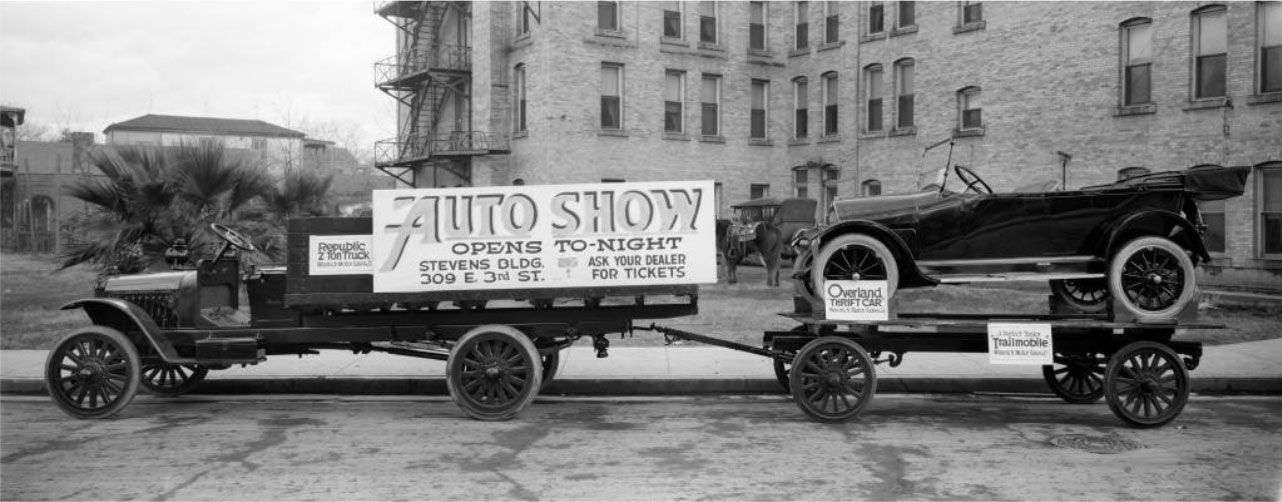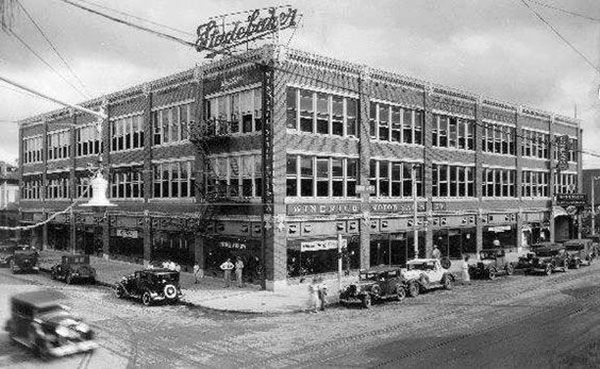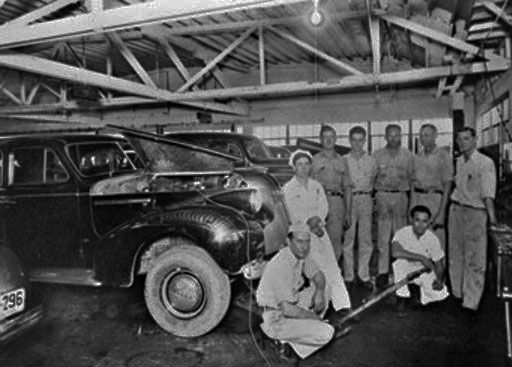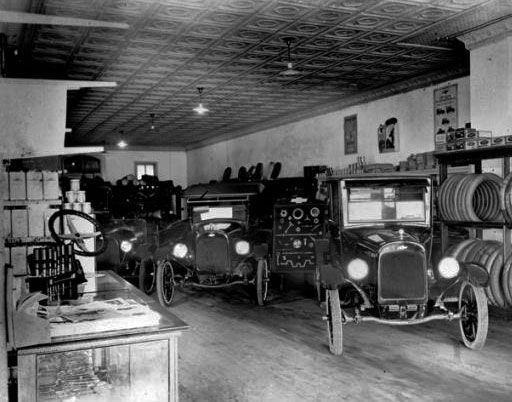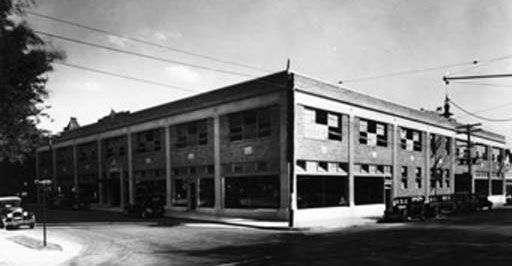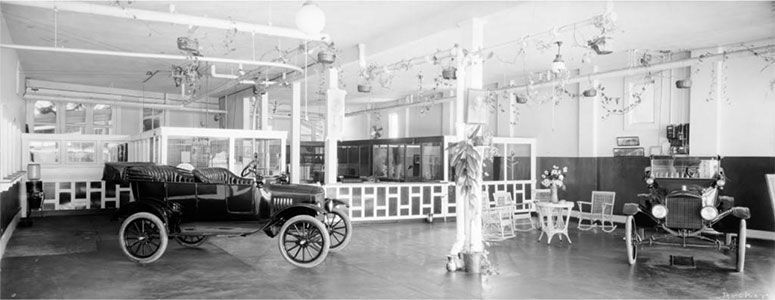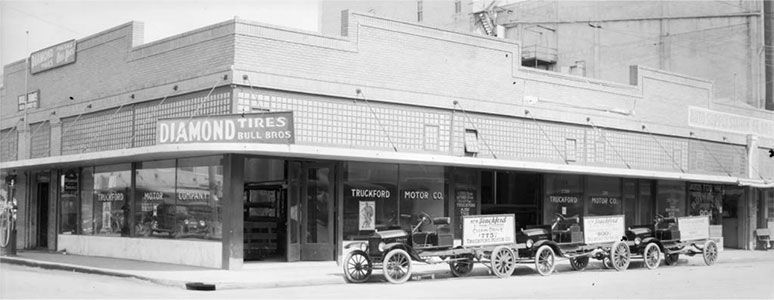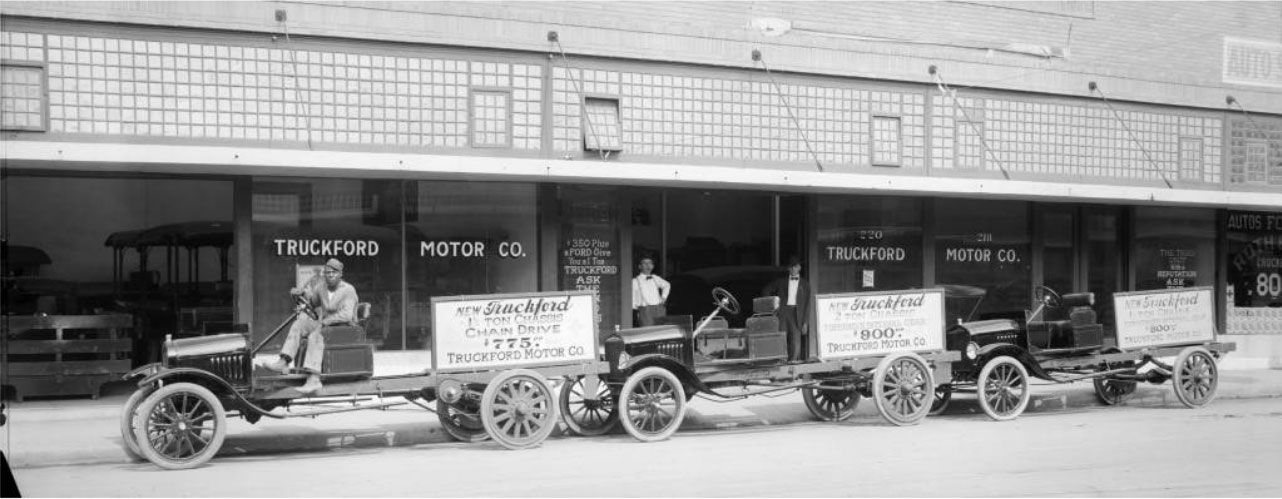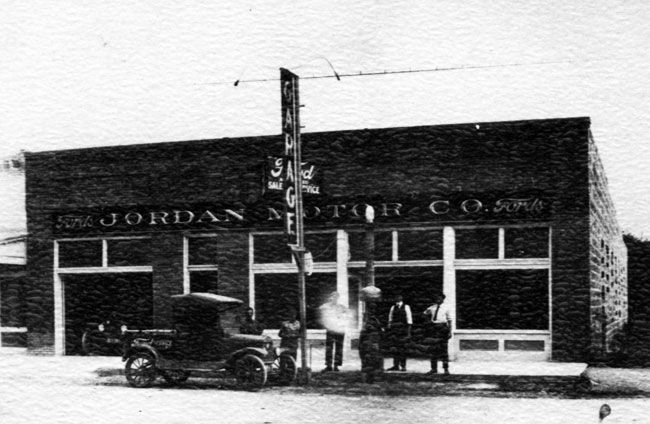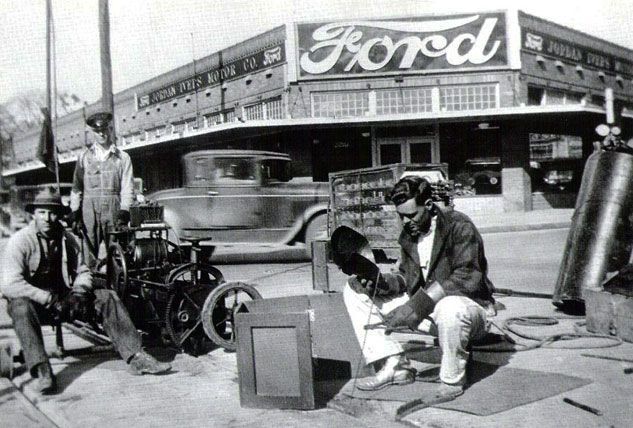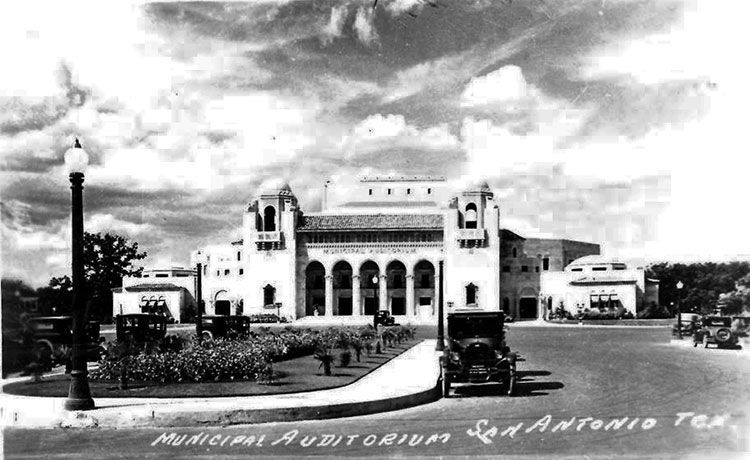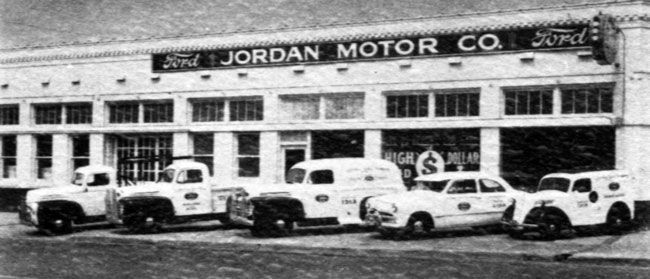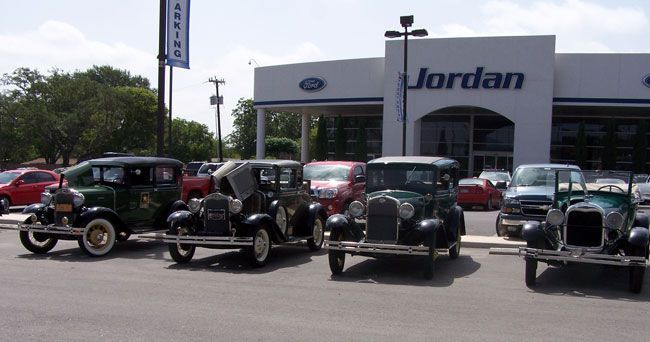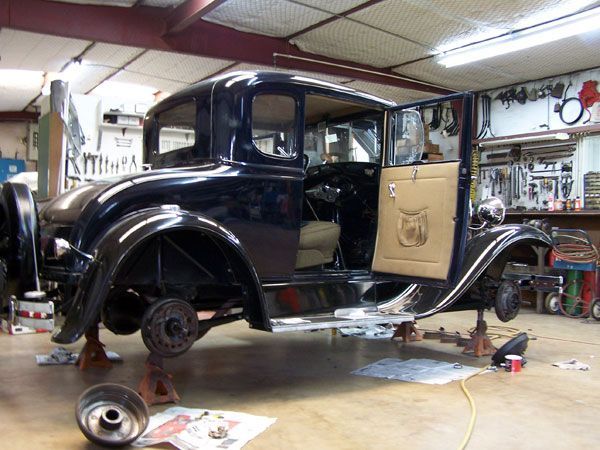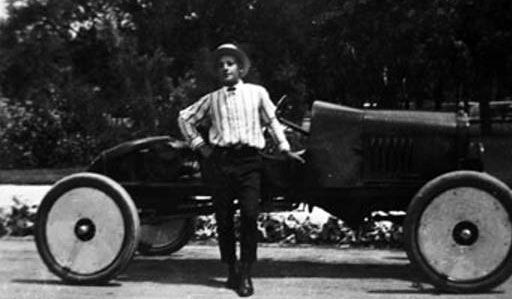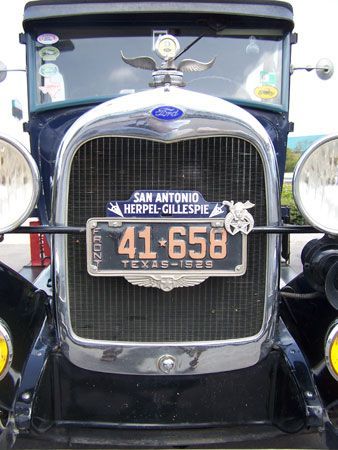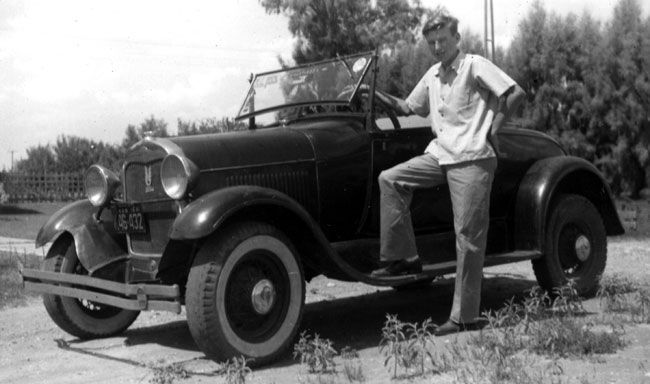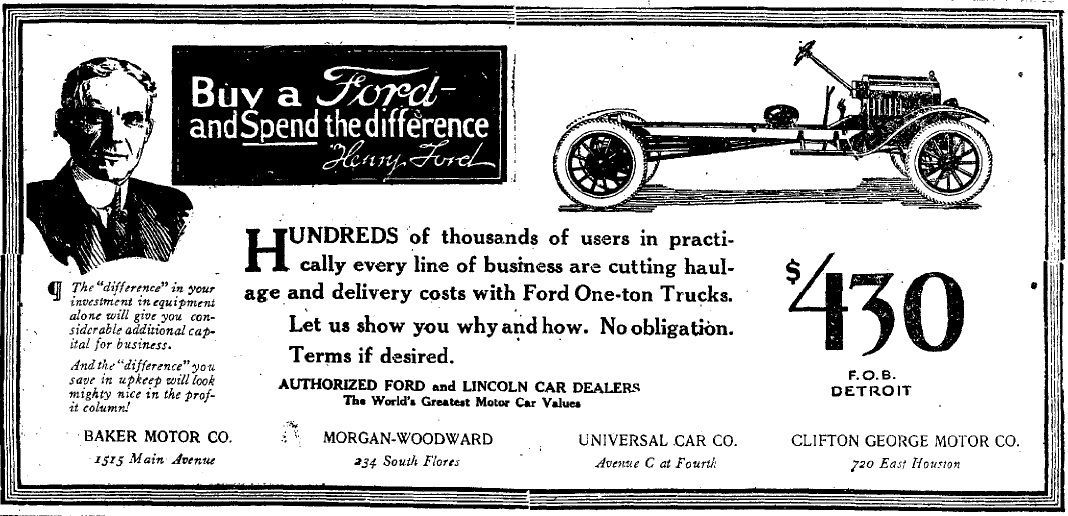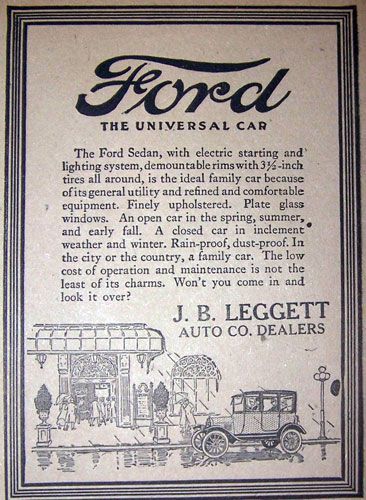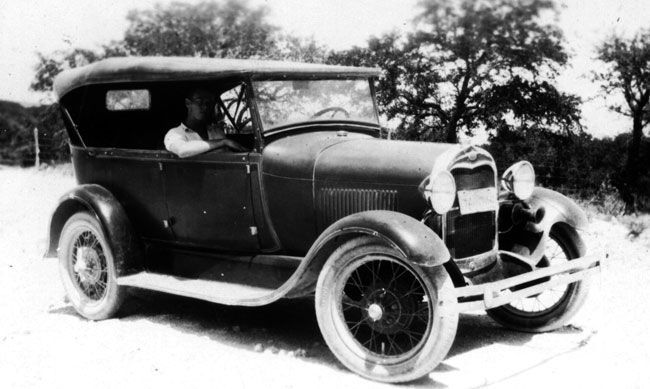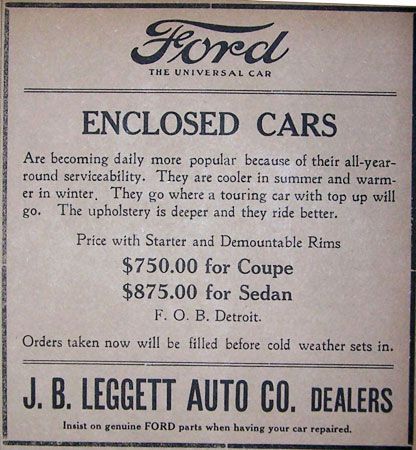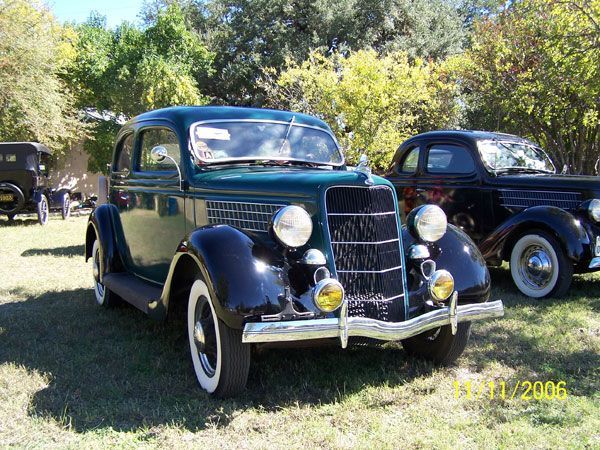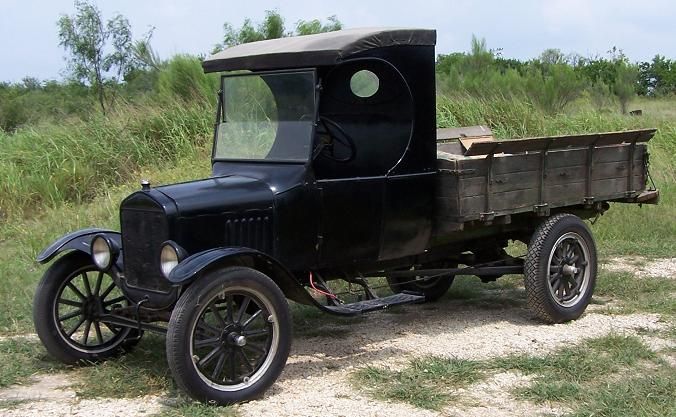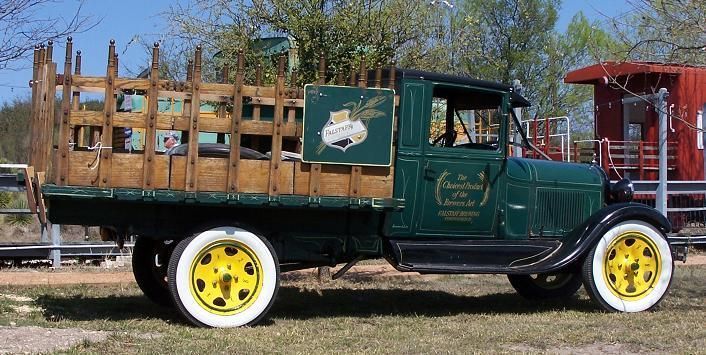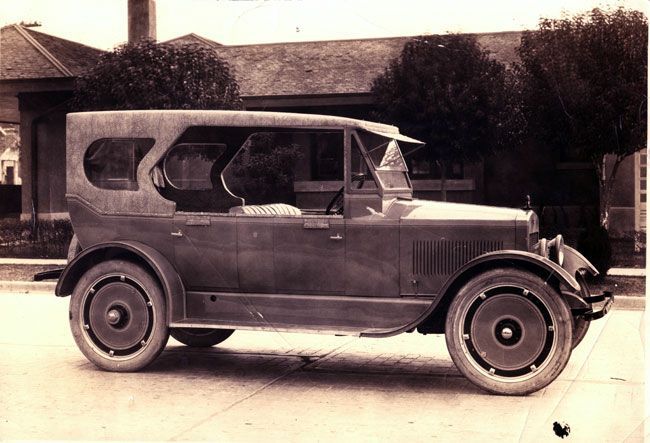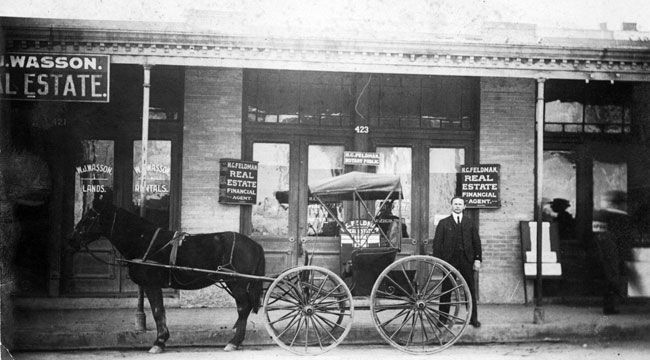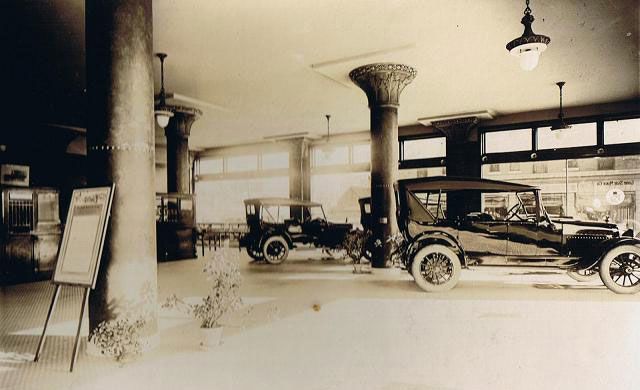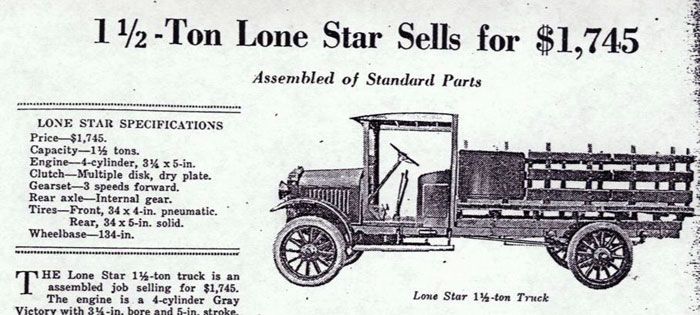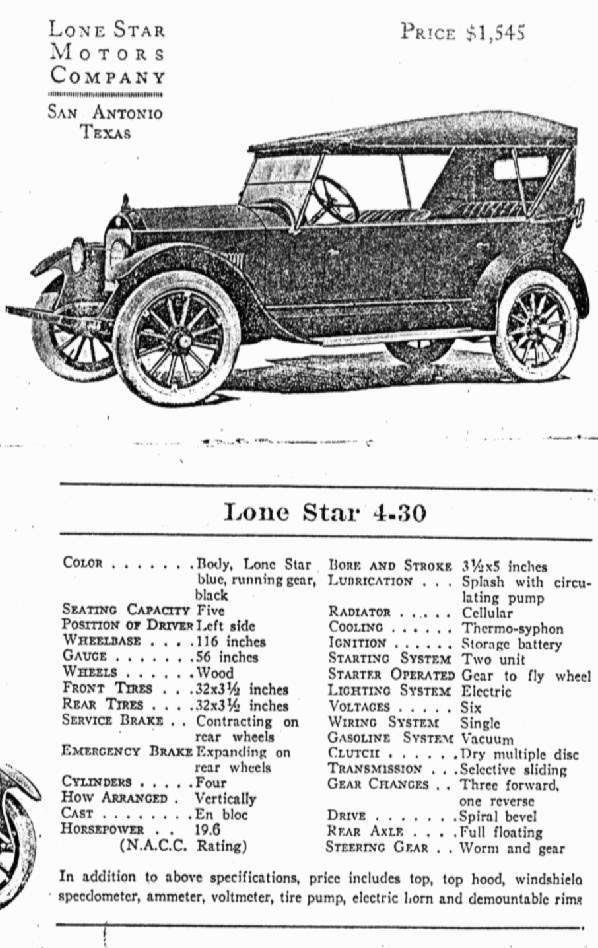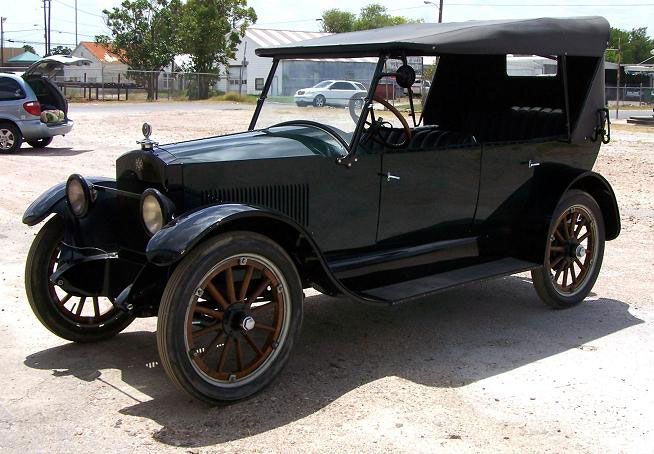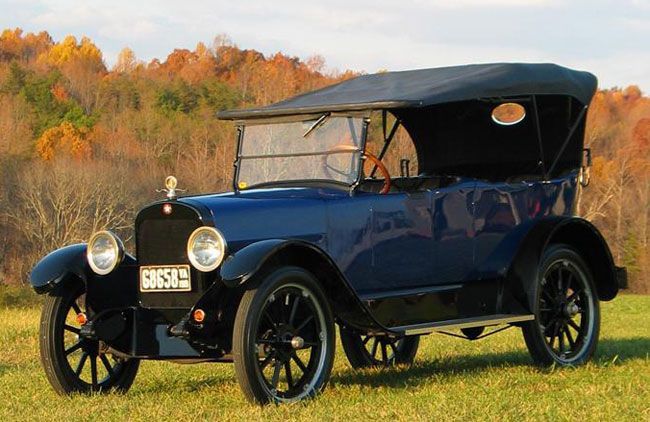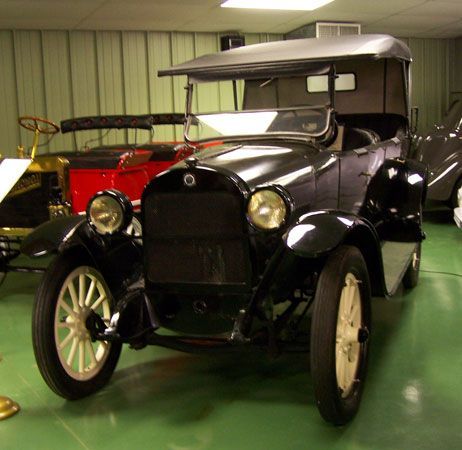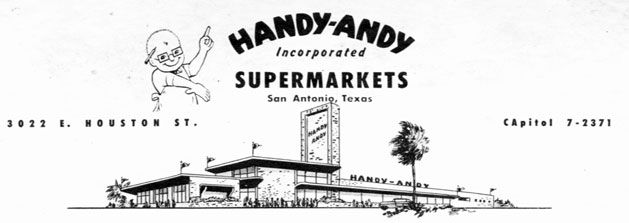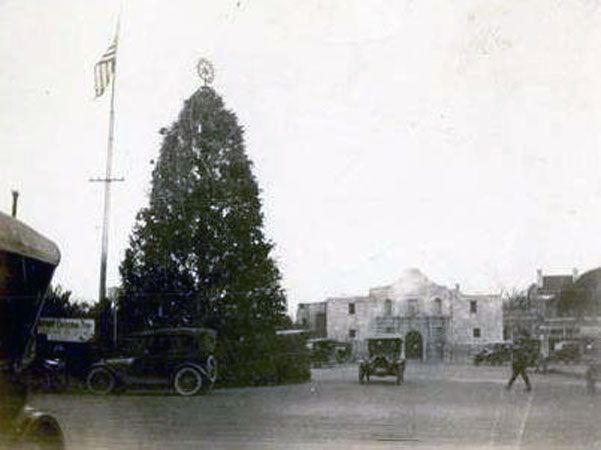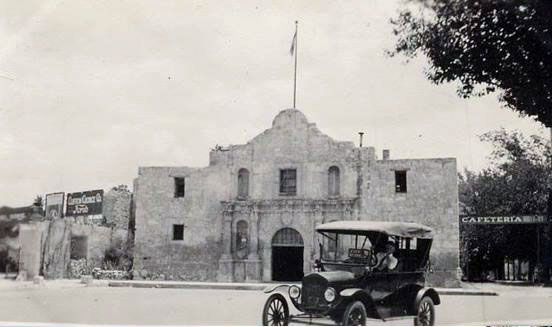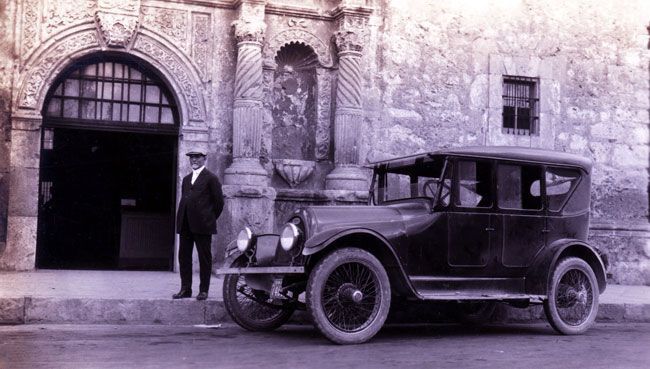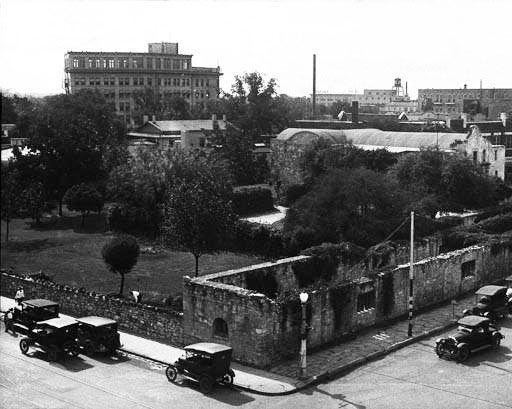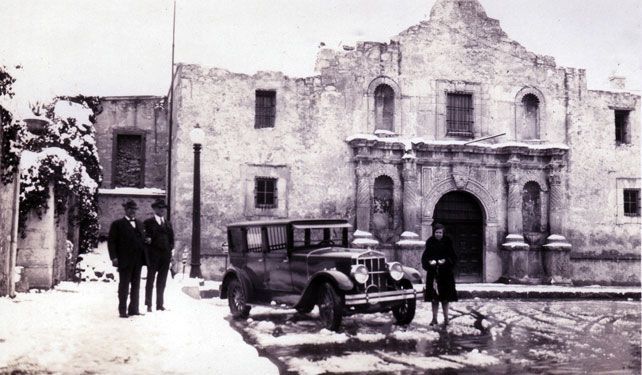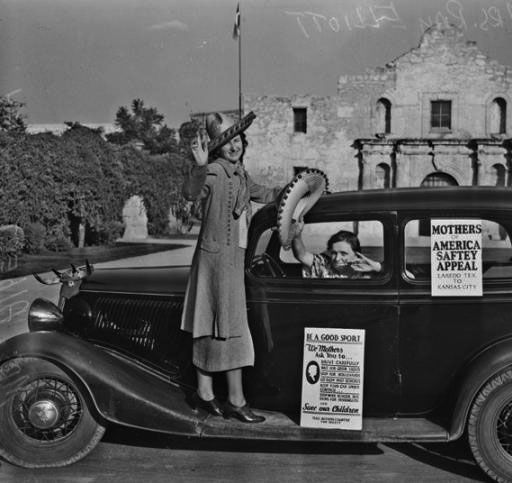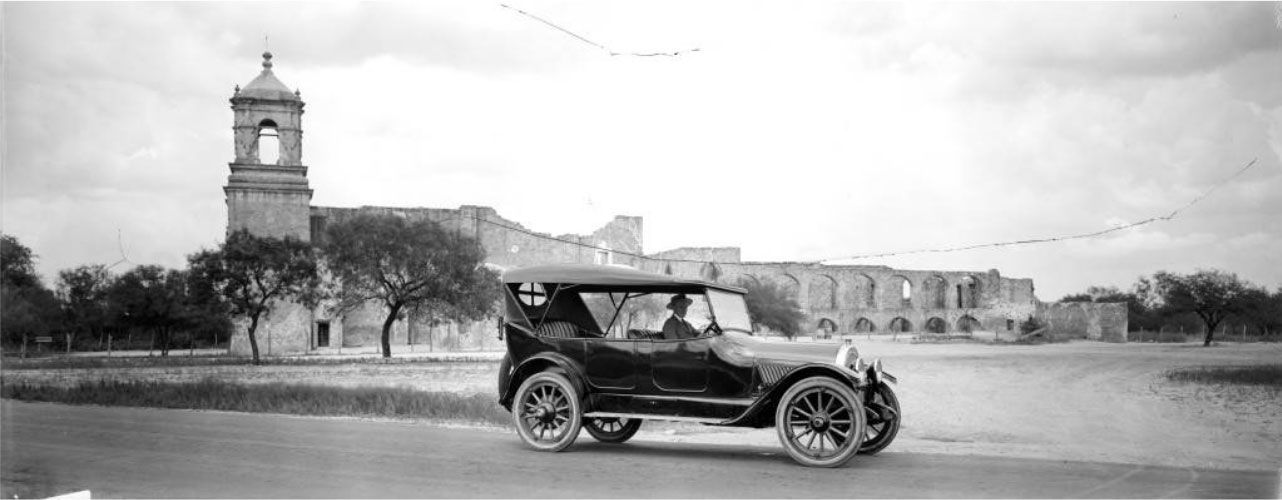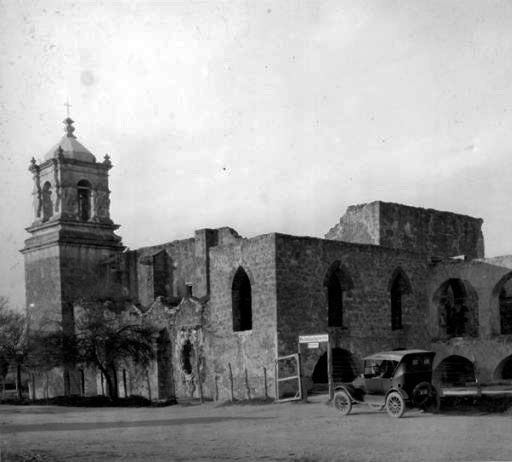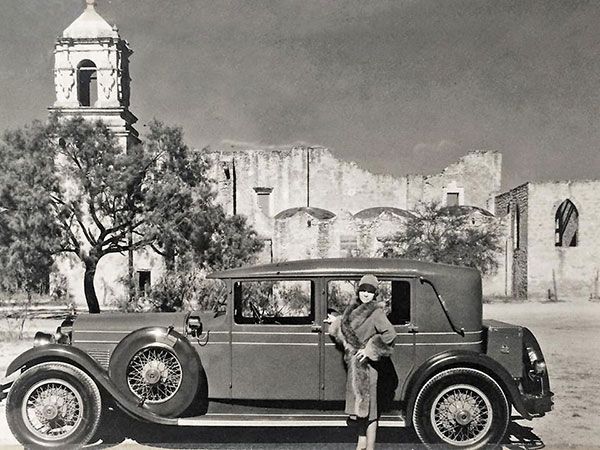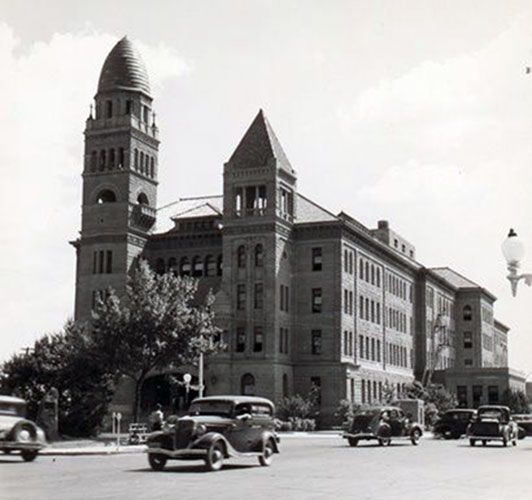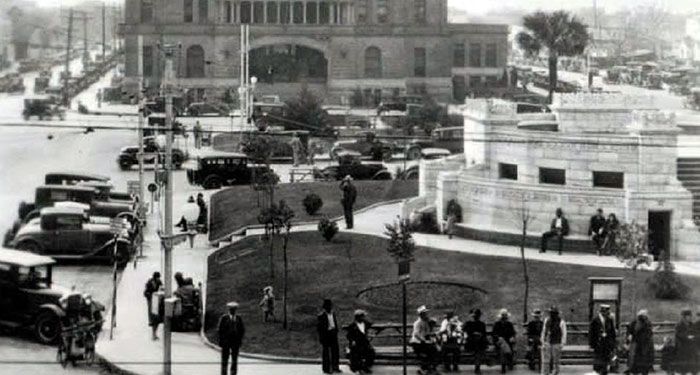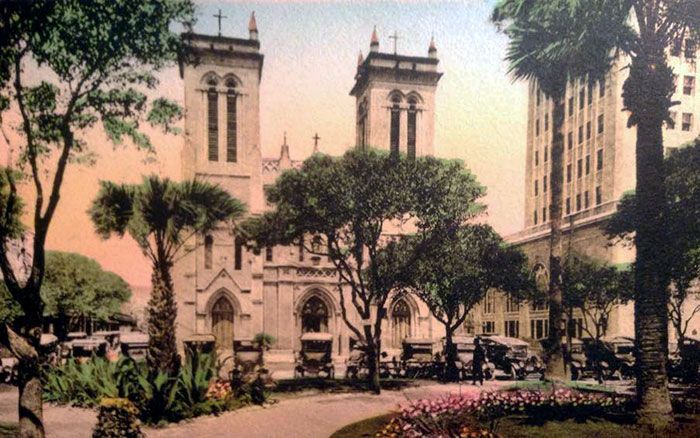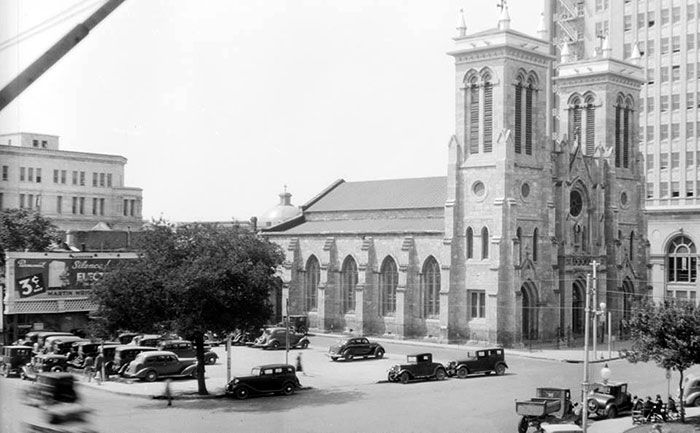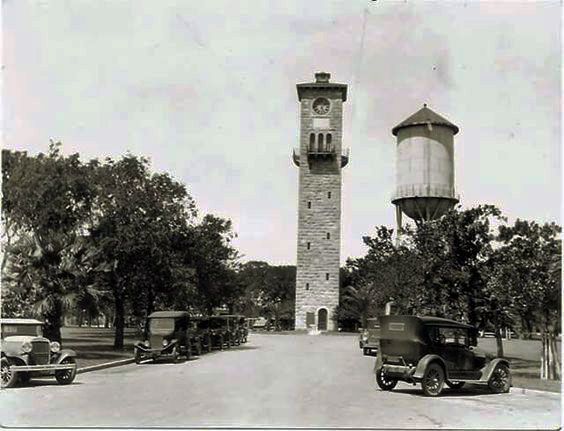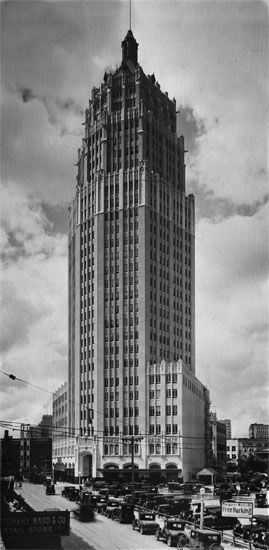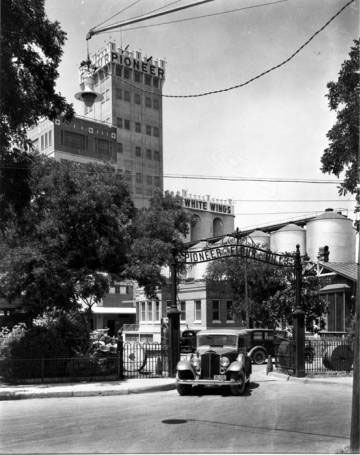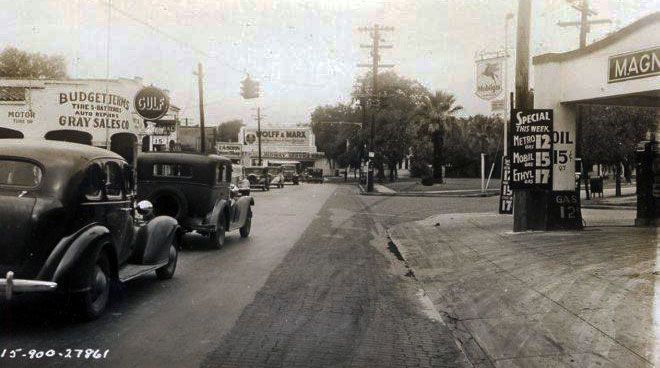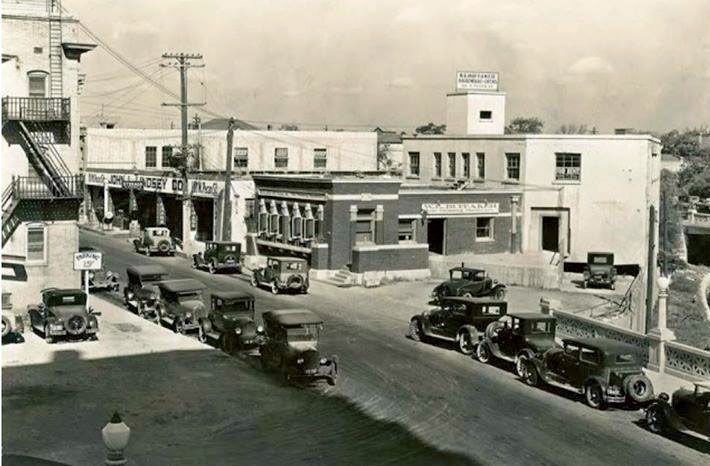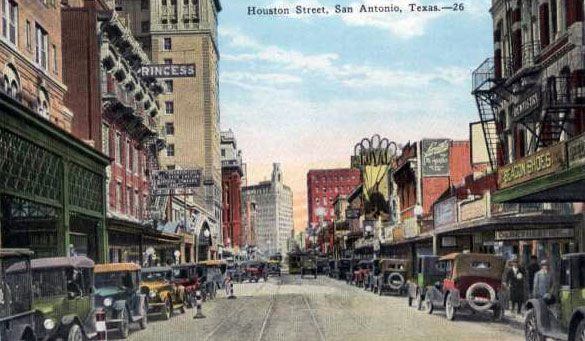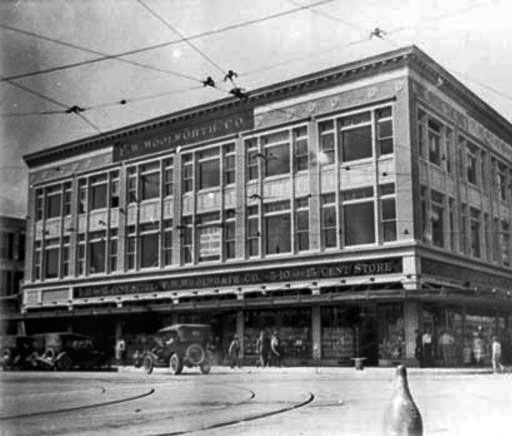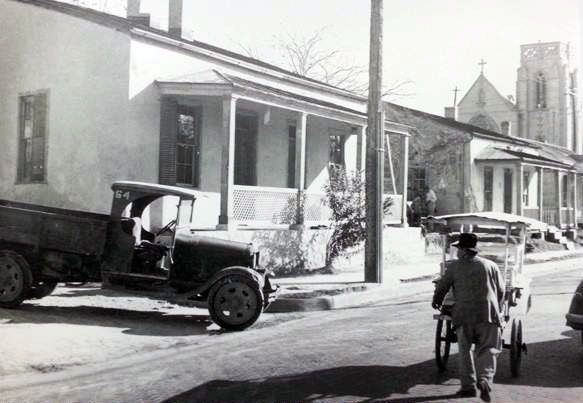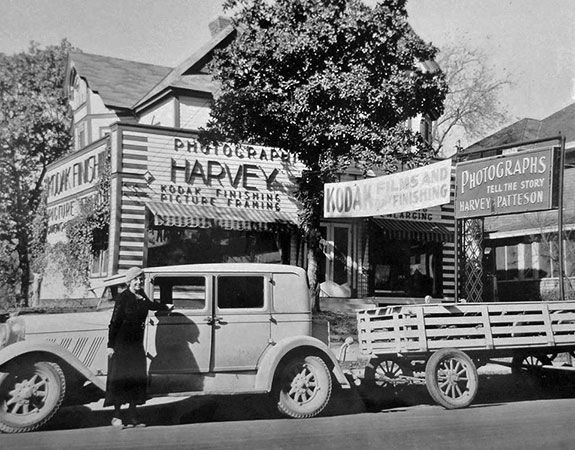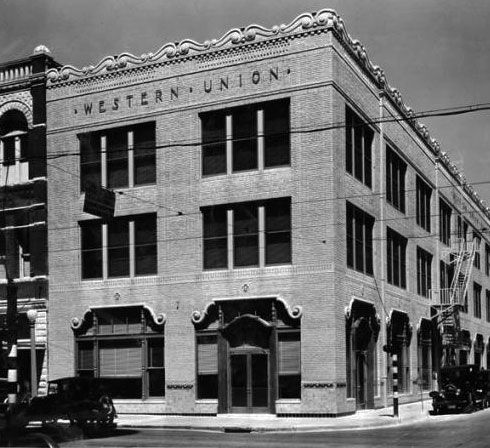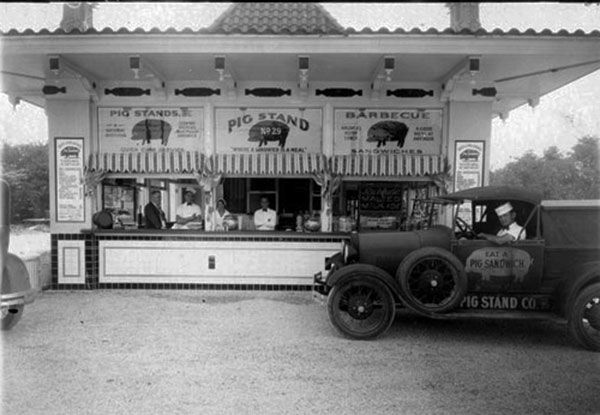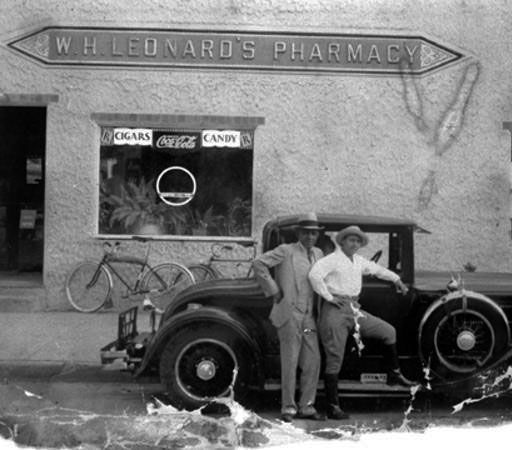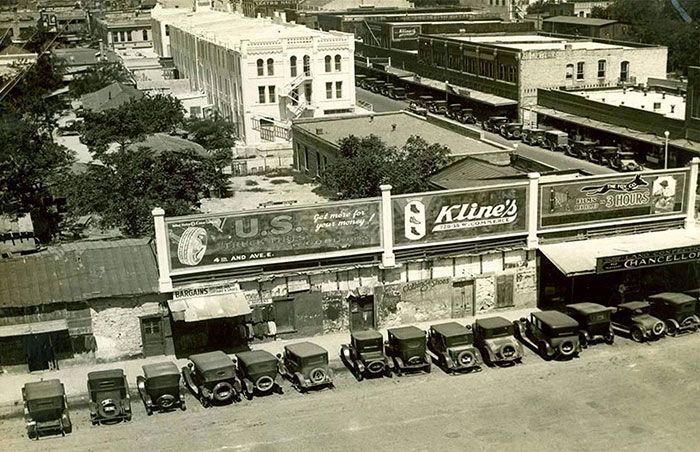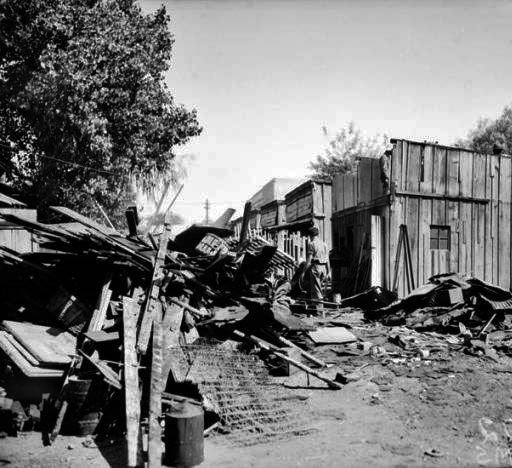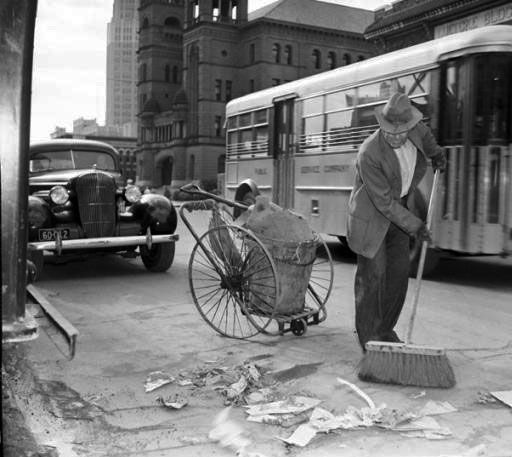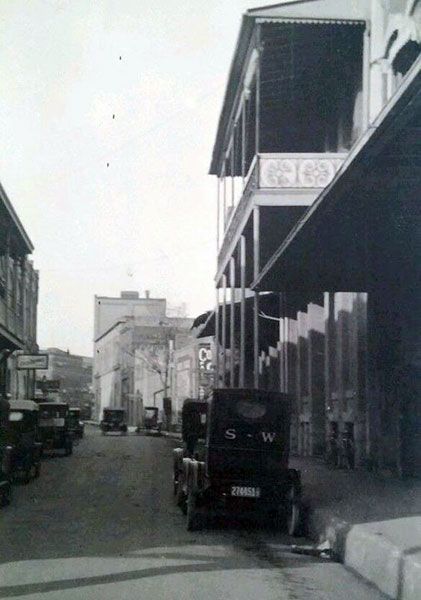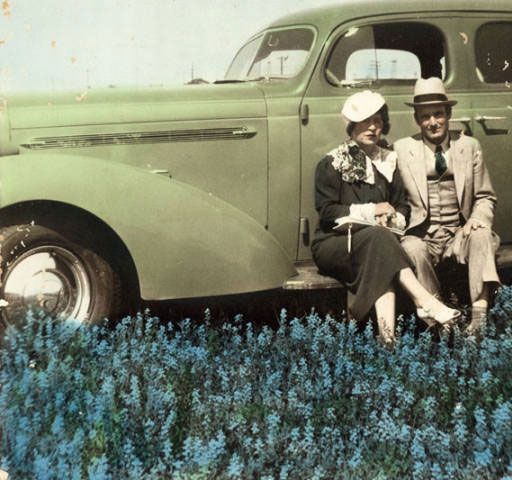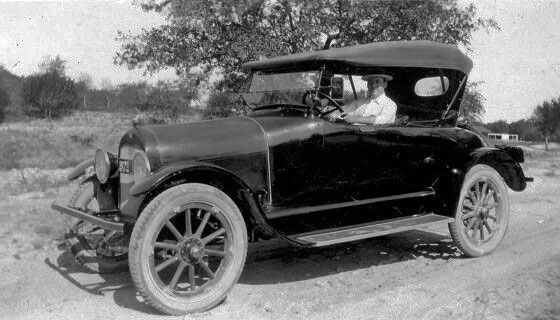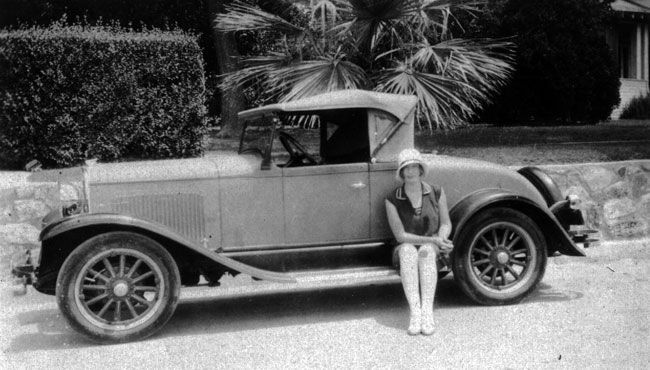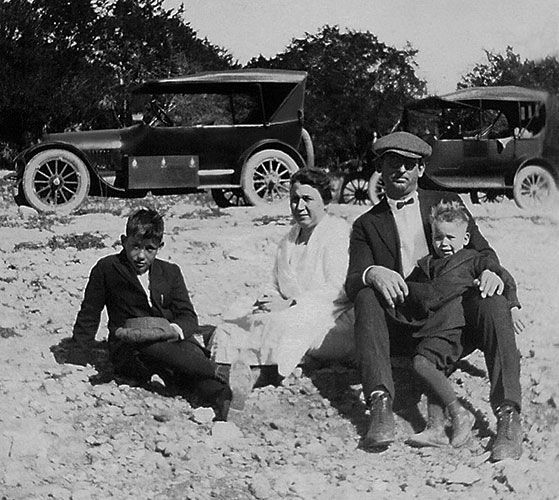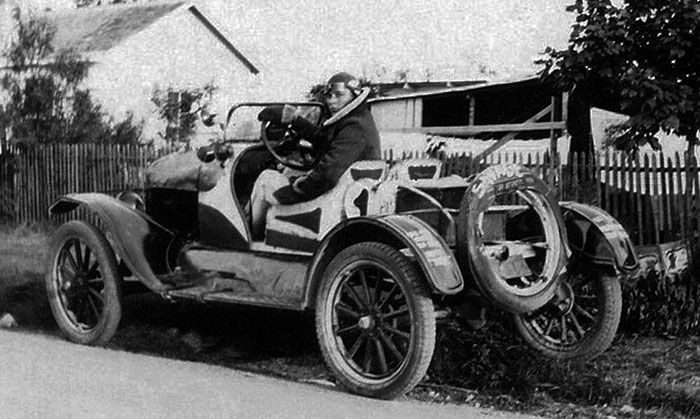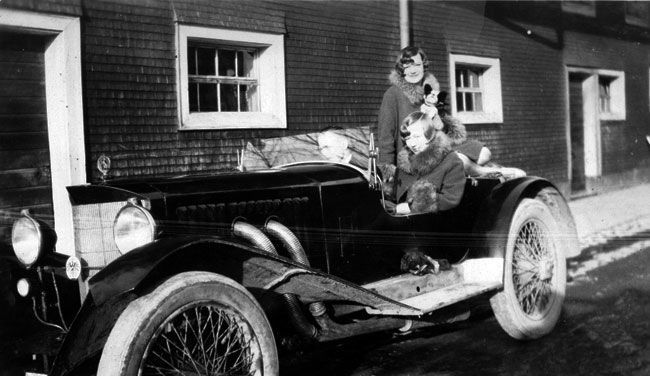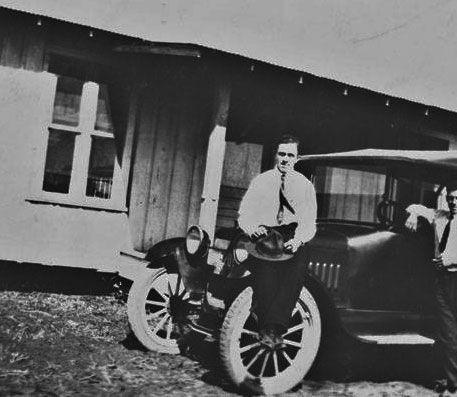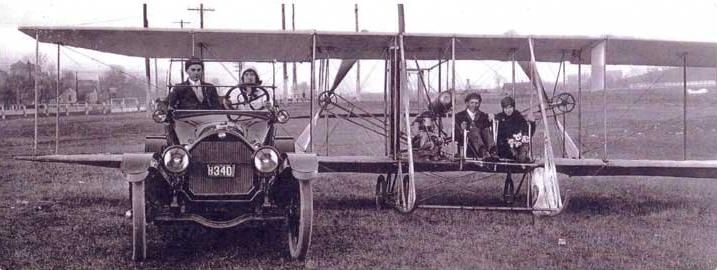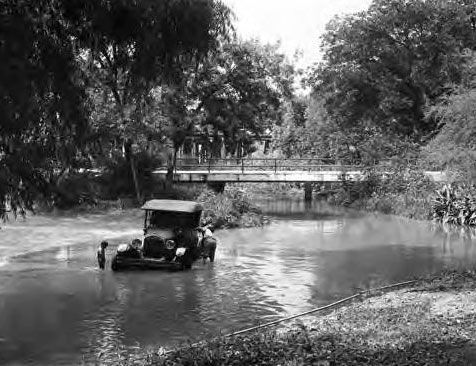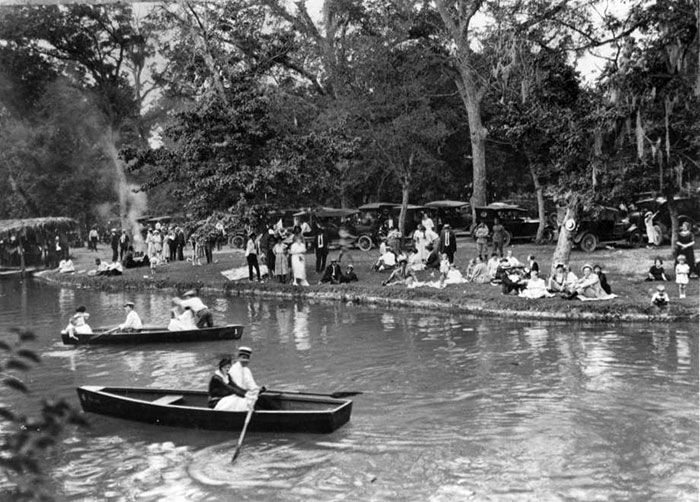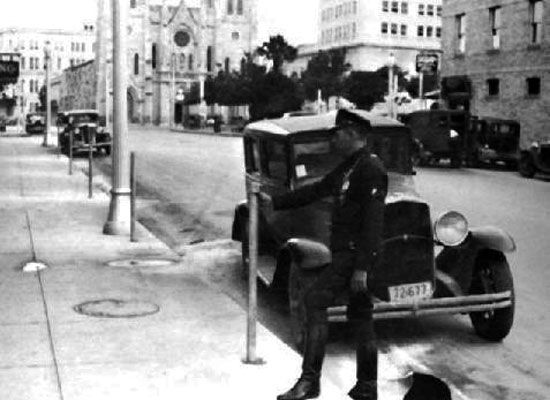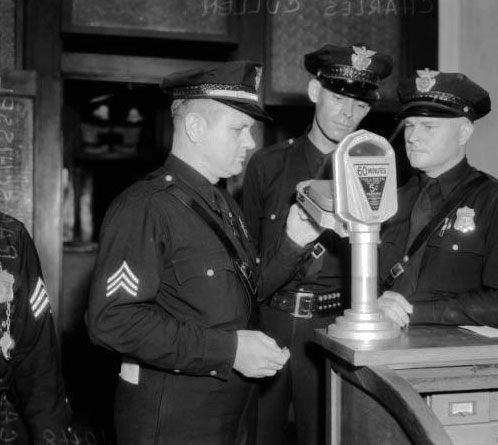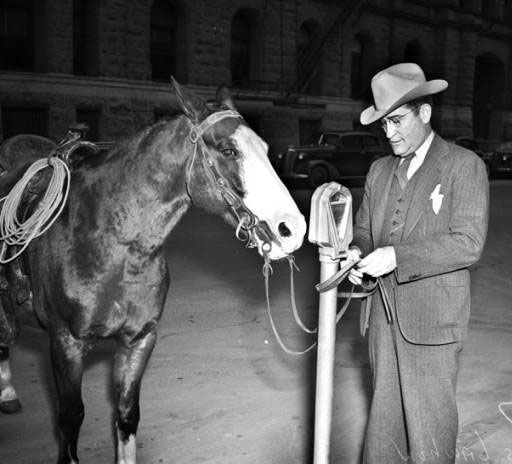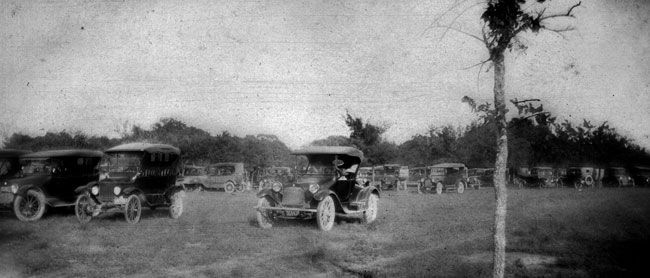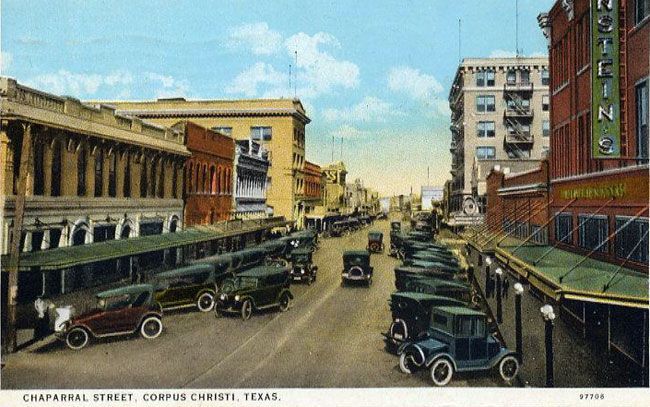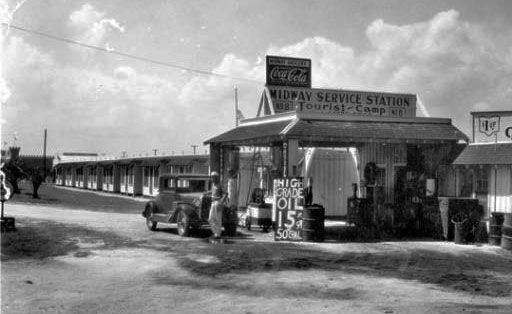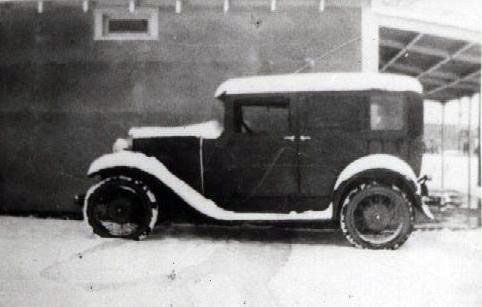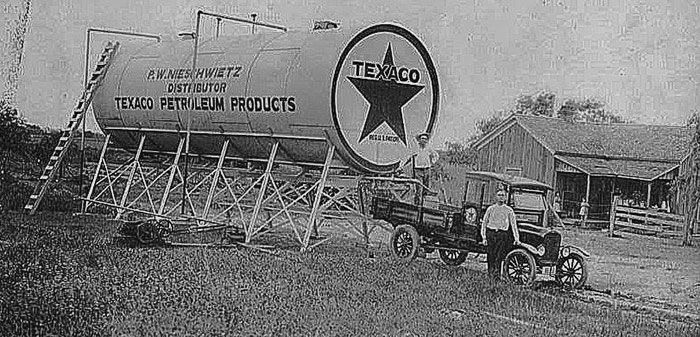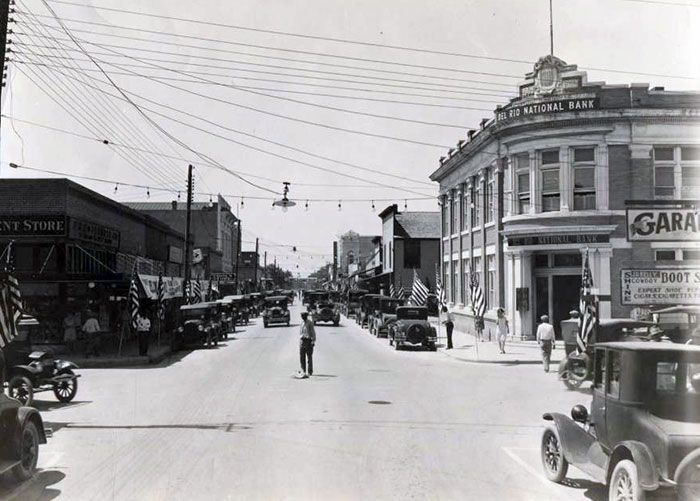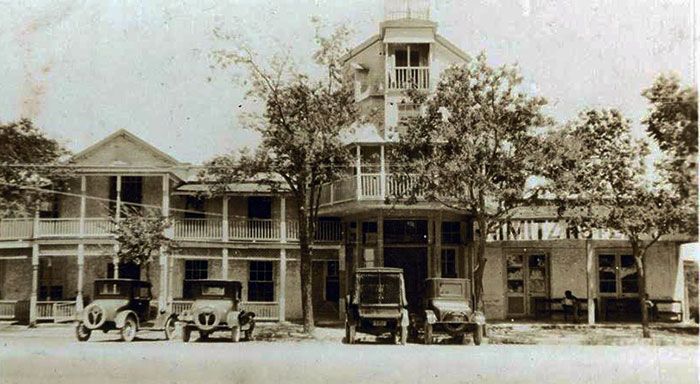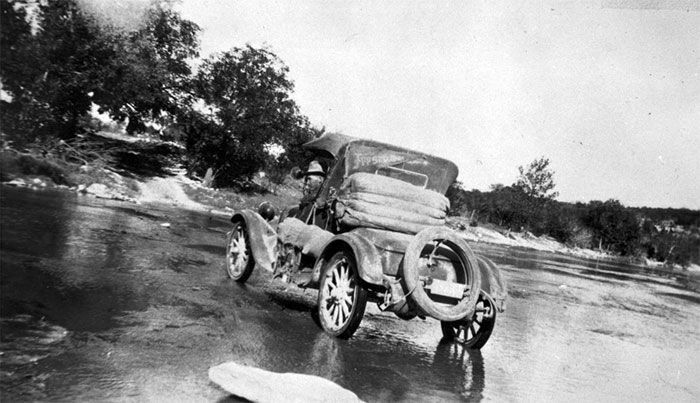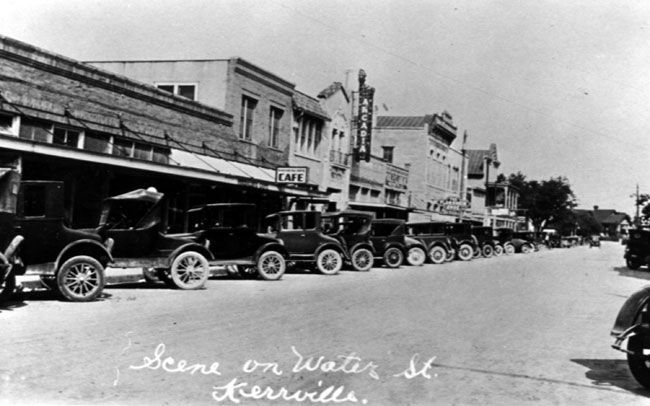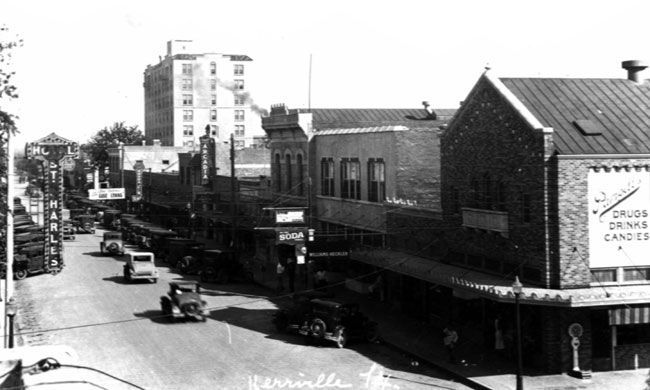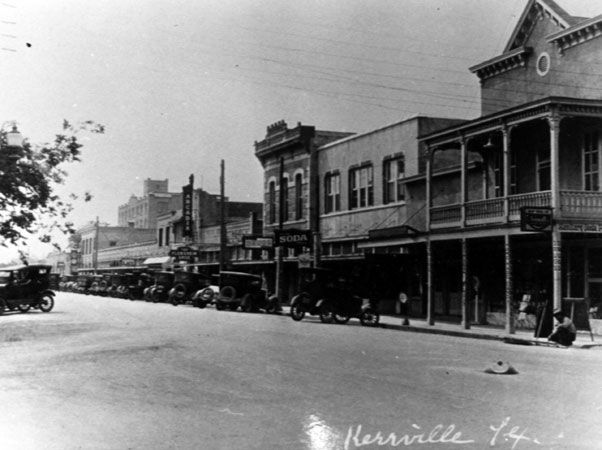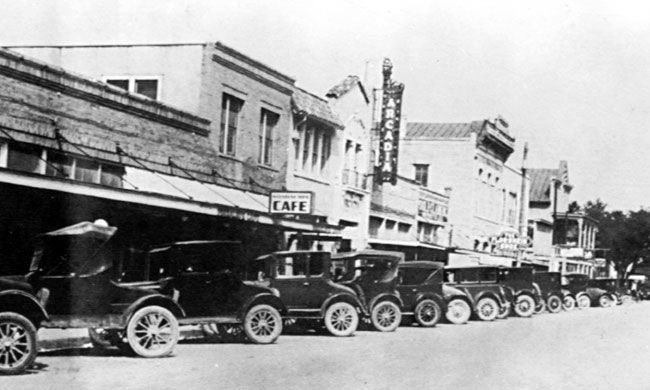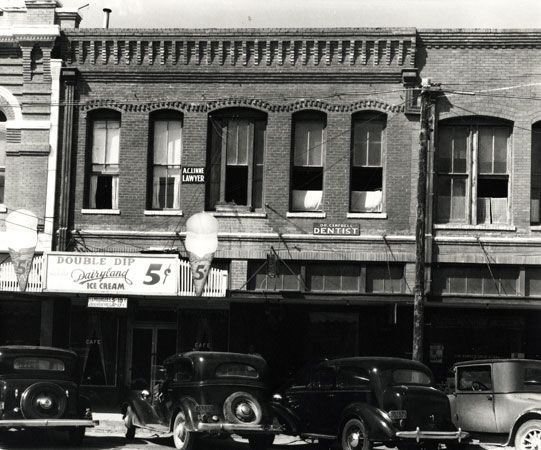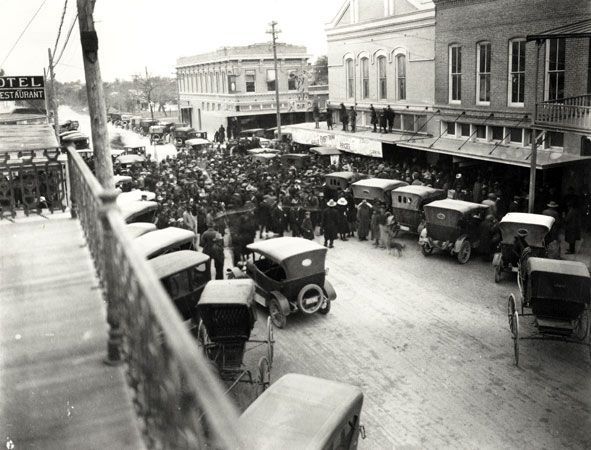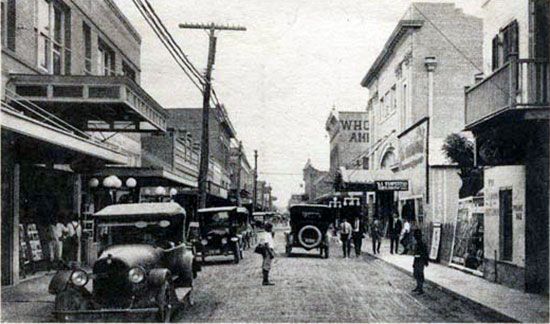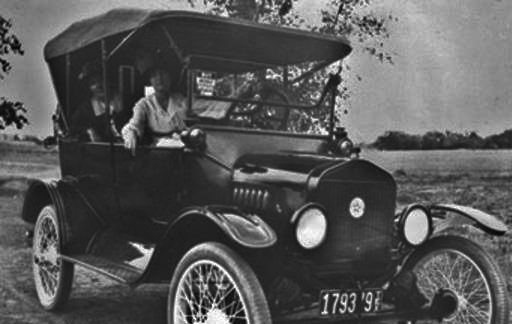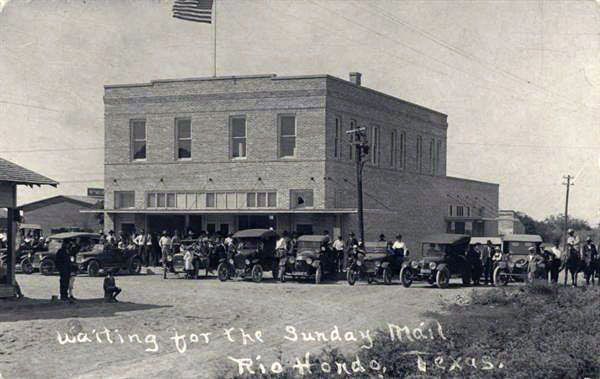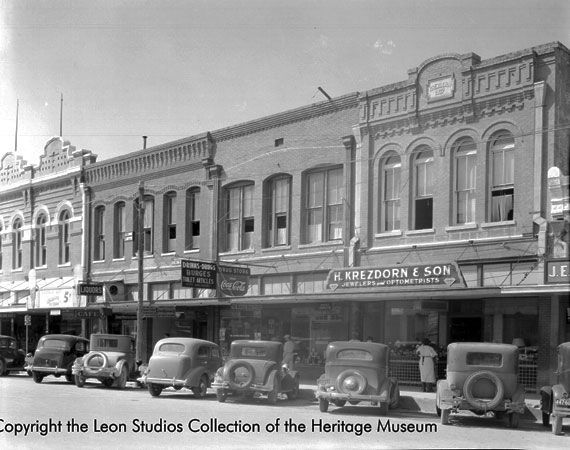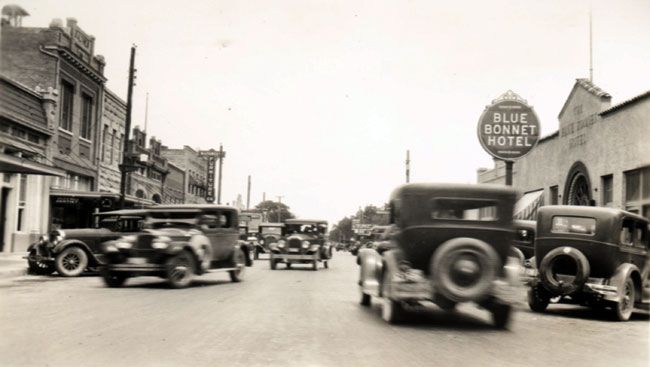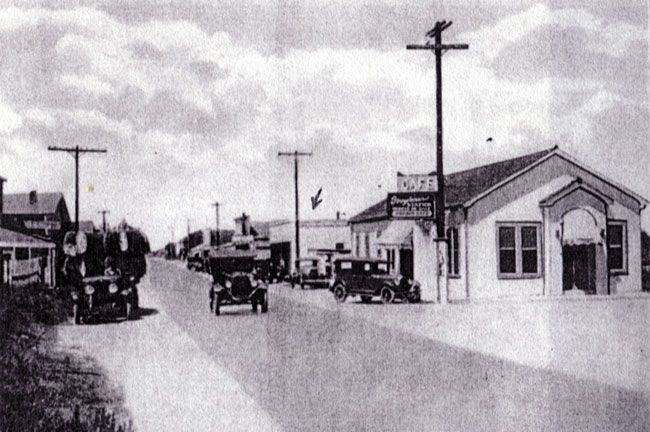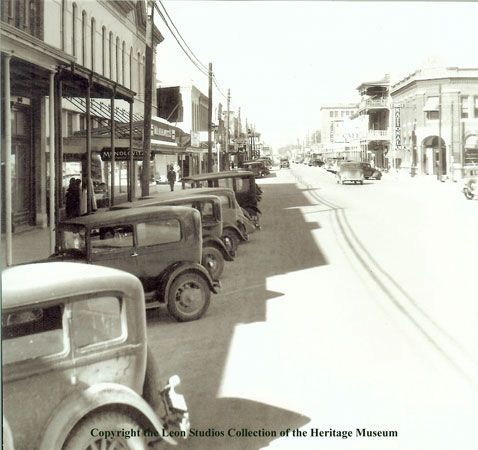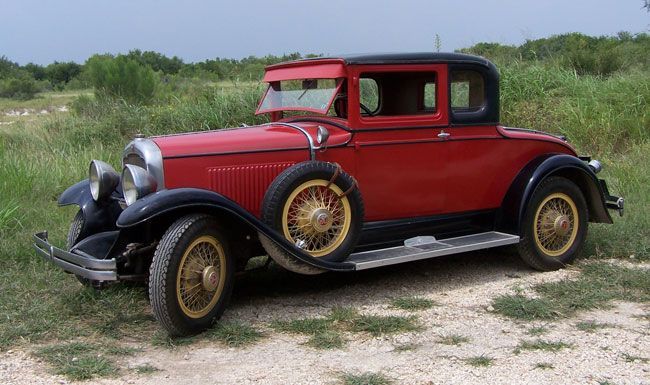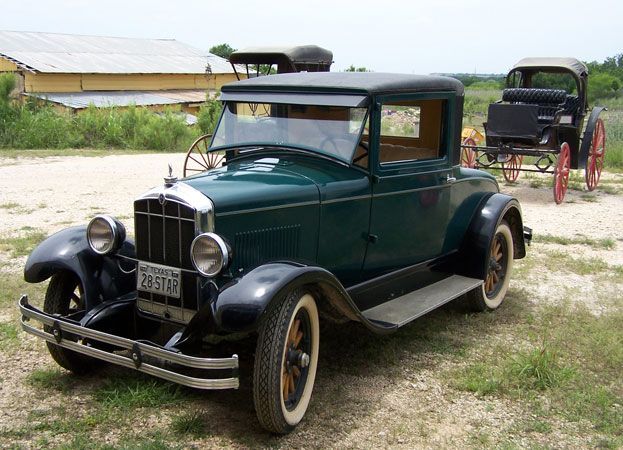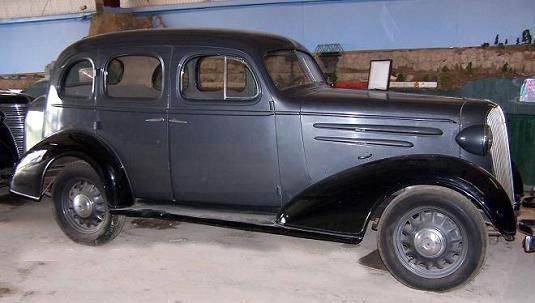Automobiles in San Antonio, 1917 - 1944
Federal Road Aid Act of 1916
The biggest step towards the creation of the modern highway system in America came in 1916 with the passage of the Federal Road Aid Act, the first significant federal legislation to address the need for better roads in the automobile age. A Bureau of Public Roads had been set up within the Department of Agriculture in 1893 but was provided little authority or funding. In 1907 the US Supreme Court ruled that the federal government had the right to create interstate highways under its constitutional authority to regulate interstate commerce. Funds for post roads were included in the 1912 Post Office Department Appropriations Act. In Texas federal money went to improving the rutted trail between San Antonio and Austin with a sixteen foot wide macadam Post Road, which for years was touted as the best road in the state. However, many southern states, including Texas, resented Federal interference, particularly with regards to enforcing fair and equal labor practices for Anglo and non Anglo employees. This led to widespread southern opposition to any further efforts to involve central government in more highway projects. Nonetheless, the landmark 1916 Federal Road Aid Act did finally pass. It set up a 50/50 funding mechanism between central and state governments. Requiring review and renewal every four years, the evolving legislation brought brought more and more federal oversight. The Texas Department of Transportation, or TxDOT, was finally created in 1917. Texas was one of the last states in the nation to create such a department and only did so because it was the only way they would receive any federal funds. TxDOT took over responsibility for highways from county and city governments.
World War One, which the USA entered in 1917, greatly speeded up development of automobiles and trucks, and revealed the deficiencies of the existing national road network, if muddy, rut filled, trails could even be called that. Larger, faster and heavier vehicles demanded better highways, roads and streets, and the demands of war loosened up purse strings like never before. As roads improved and wealth increased during the "Roaring 20s," the automobile became increasingly popular. Travel by rail began to decline during this decade. Buses became larger and more comfortable. They could be operated at far less cost and with greater frequency. At the same time, the support infrastructure for powered vehicles, including gas stations and dealerships, became an intrinsic part of the landscape.
San Antonio Police & Fire Departments
The San Antonio police department acquired its first motorized vehicles, air-cooled Franklins in 1910. It acquired motorcycles the same year. The first motorized fire engine transported men and equipment in 1910. Fordson tractors replaced horses to pull steam pumping units until specialized vehicles based on truck frames were developed, but the department continued to use some horse teams until 1927. The posted speed limit in the downtown business district was a mere 10 MPH. Just outside this zone it rose to 18. Within the remainder of the city it was 25. but persons being passed on the highway were supposed to slow to 15 as most roads were still only sixteen feet wide, so the margin for error was very limited. In 1919 Comal County posted speed signs in and around New Braunfels and hired two motorcycle officers to enforce the 18 MPH speed limit on Highway 2 between San Antonio and Austin. The first electronic traffic lights in America were installed in Houston in 1922. San Antonio got its first set one year later. In the same year, 1923, the SAPD retired its last horses, and set up a unit to deal with the growing problem of automobile theft.
San Antonio police cars and motorcycles
Gas and Service Stations
Finding gasoline was a hit and miss affair for early motorists. It took several decades for the support infrastructure we take for granted today to evolve. In the infancy of the automobile age, you had to find a livery stable, a blacksmith or a hardware store that carried the highly combustible fluid. If you were lucky they might have it in one gallon cans, the same kind that was also used for motor oil. More than likely, however, the fuel was stored outdoors in a large raised tank made of either wood or metal. Sometimes you even had to use a bucket to transfer the gasoline to your vehicle. At this time the vehicle’s gas tank was often under the driver’s seat and not all that easy to access. To avoid getting contaminants into your own tank, it was advisable to strain the fuel through a chamois leather. Beyond rust and other debris, the biggest concern was water. As the storage tanks cooled at night, condensation formed inside, and as they emptied, the problem became worse. Putting the tanks underground, and better ventilation techniques helped to reduce this problem, but this require a huge investment whereas gravity was free. Water contaminated gas caused engines, many gravity fed themselves, to run rough, misfire or stall completely.
Early gas stations and garages in South Texas
The first fuel pumps were simply located on the edge of the sidewalk, outside a store that could be selling anything. It was quickly realized that this was incredibly dangerous. One bad move by a driver could bring about a catastrophe. Modern filling stations began to emerge around 1912. One of the first was in Houston. These were characterized by pumps on raised islands in the middle of a fore court well off the main roadway, with underground tanks to hold the fuel, which was both safer and reduced condensation. The customer or an employee would hand pump fuel into a sight glass at the top of the pump. This allowed the customer to see exactly how much gas he or she was getting before gravity drained it into the vehicle’s own tank. Developing a network of filling stations took several decades. The earliest maps produced by automobiles clubs and tourist organizations like the Old Spanish Trail Association tried to mention as many locations as possible but it was always advisable to carry extra fuel, as well as tires and water for the radiator, well into the 1930s, especially if venturing out in the hinterland.
Early gas stations and garages in South Texas
Most of the first dealerships sold gas and tires, plus other vital spares, and often made more revenue from servicing of cars than they did from vehicle sales. Fixing tires was particularly profitable, and urban legends abound of unscrupulous service areas strewing nails and other sharp objects within easy traveling distance from their shops to "encourage" business. And spiralling gas prices are nothing new either. The cost of gasoline doubled from 15 cents to 30 cents a gallon in 1920. The newspapers of the time were full of commentary and cartons depicting oil companies as evil, plus tips on how to save gas, just like the media today. By this time almost half the gas being sold was from filling stations. By 1929, with 121,000 stations nationally, they were responsible for 92%. They were now called service station as they were also selling parts, tires, replacing glass and performing repairs. In San Antonio they were often located at ice houses, as long established corner stores added this service to their sales of ice, bread, dairy products and beer, in the days before electric refrigeration was introduced. This was due in large part to Billy Daren, the entrepreneurial genius behind the creation of General Motors in 1908. He coined the name “Frigid ai re,” which would remain a part of GM until 1979.
Early gas stations and garages in San Antonio
Some gas stations on the west side of San Antonio because far more than just simple service stations. They became impromptu community centers, with parties and dances a staple of their activities, with bands playing on the roof in the evening. When any of the remaining structures is demolished, although long abandoned, local people in the community know they have lost something special. While most local service stations were independently owned, most were "franchised" with one of the major fuel suppliers. Within San Antonio there were three dominant oil companies until 1920; Gulf Oil, now part of Chevron, Magnolia, which provided the Pegasus symbol to its successor, Mobil, and the Texas Company, better known today as Texaco. Each initially used curb side pumps before evolving unique building designs and signage to distinguish themselves from a distance. Gulf, which began processing Spindletop Oil in 1901, first used hexagonal boxes with overhanging canopies at the center of their filling stations. Magnolia used a small hut with a large continuous canopy and the Texas Company used a dog run style with a continuous roof over two separate rooms with a space between for cars to drive through to access the pumps. These companies were joined by Cities Service, which employed a Mission inspired Spanish Eclectic style with tiled roofs and raised brick pilasters at each corner of the main building and unshaded pumps in the fore court. Humble Oil, which is now part of Exxon, also arrived in San Antonio, using a house with canopy design, with brick veneers and supporting columns.
Early gas and service stations in San Antonio
Most early gas stations were located right in the heart of residential districts and were grandfathered in when zoning became acceptable. Initially zoning laws were initially viewed as unconstitutional restrictions upon the rights of property owners, a legacy of the prevailing Texas attitude that any restriction imposed by any form of government is inherently bad. On the other hand, it is hard to imagine that King William residents today would allow a Texaco gas station opposite the Anton Wulff house, now the headquarters of the San Antonio Conservation Society, but these older structures, many no longer selling fuel, are now part of the urban landscape. In fact the old Texaco Station mentioned now sells coffee, with a table or two in the shaded fore court. On certain streets, like St Marys, the profusion of wildly painted re-purposed gas stations is very noticeable, and recalls the time when such streets, now fairly quiet once acted as arterial roads, with an entirely different ambiance than they have now. One type of filling station structure that San Antonio was noted for would be impossible today: multi-story buildings on busy downtown street corners with open areas on the ground level for cars to access the pumps, and the floors above were rented out as offices. Mainly used by the Magnolia Company, several of these structures, still stand, but their ground floors have been re-purposed, sometimes as open or enclosed parking for the businesses above.
Early gas and service station advertising in San Antonio
In the 1930s another Texas company, Sinclair, came onto the scene. This company, which was the sum of many older parts, such as the Pierce-Fordyce Oil Association, favored very ornate structures, some with two canopies, with stucco exterior walls, distinctive gables and pent roof parapets covered with green tile. Sinclair’s gasoline supply operations were either acquired by BP, British Petroleum, or Valero, a San Antonio based company, which used to call its gas stations Diamond Shamrock, now one of the largest oil refiners in North America, and a Fortune 500 company. Over time most of the original companies changed hands and corporate identities. The Dutch company, Shell, bought out Texaco, and Mobil merged with Exxon.
Automobile Dealerships and Car Shows
The city’s first car dealer, L.F. Birdsong, began offering Curved Dash Oldsmobiles in 1902 at 214 E. Houston, where he and original partner, Frank Crothers, had sold bicycles and Kodak Box Brownie cameras since the late 1890s. One of his first customers was a Mr. Vaughan. Following Ransom Olds decision to leave company he started in 1908 and create REO, Birdsong and new partner, George Potchernick, began selling Maxwells, Stoddard-Daytons, and the low cost Brush. Potchernick, who had opened San Antonio’s first automobile parts and accessories store, never played an active role in the dealership. He is best known best known as the owner of s sporting goods and outdoor adventure store on N. St. Marys Street. The fortunes of Birdsong & Potchernick might have been greater if they had known that Oldsmobile would become a huge part of General Motors, formed in 1908 by Billy Durant. But who was to say that General Motors would even survive in the face of the ultimate competition, Henry Ford’s Model T, introduced the same year? Birdsong then became a true believer in the air-cooled Franklin in 1912 and was not interested in anything else.
Following the destruction of Birdsong's original building on Houston street, where the Majestic theater now stands, during the 1913 flood,the dealership moved into a former livery stable on Avenue D, soon renamed N. Alamo, selling air-cooled Franklins exclusively. When Birdsong accrued enough capital, he bought out Potchernik’s share in 1917. In 1920 he relocated to a larger leased property across the street at the corner of N. Alamo and Travis. In 1925 he bought a large site at the corner of N. Alamo and 7th Street and opened a used car outlet there in 1928 after he demolished some existing structures and built a new building. At the same time he moved sales of new Franklins to a leased property at 712 Broadway. As technically sound as they were, the public never shared Birdsong's commitment to air-cooled engines, and the struggles of the Great Depression did not help. By 1933 he consolidated both activities onto his own site. In 1934 the lights of the Franklin Company went out. Birdsong limped on through the depression but called it quits in 1936. Still only in his fifties, Birdsong focused on his portfolio of properties and did well enough to end his days in a fine house in Alamo Heights.
Ford in San Antonio
The Ford Model T, built for unpaved roads became antiquated and was finally replaced in 1928. Henry Ford, now becoming known for obstinacy every bit as much as innovation, kept it going long after it should have been retired. While other manufacturers coalesced into competing conglomerates with more modern products and equally low prices, he was determined to keep his beloved Model T pouring off production lines. Following his company's development of mass production techniques that had radically cut costs and improved quality at the same time, Ford realized that it was cheaper to ship parts rather than completed cars, so he set up no less than thirty-six subsidiary factories in the USA, with more in Europe and even Australia. In Texas, he chose Dallas as the location for an assembly plant. Most of the Model Ts and subsequent Fords purchased in Texas were built here. Until the facility was shuttered in 1970, it was common to see the factory window sticker saying, “Built in Texas by Texans.”
The original factory owned Ford agency behind the Alamo was transferred to Clifton George Company. In late 1920s it was was sold to Herpel Gillespie. On September 27, 1929 Frank Gillespie sold a 1929 Ford Model A Tudor two door sedan, built on August 12, 1929, to Antonio Guajardo, for a down payment of $232.06 and a balance of $492.00. This was paid in full in October the following year after twelve payments of $41.00. The car’s second owner, Bill Todt, who bought it in 1971, still drives it on the roads of San Antonio, adding some fifty thousand miles towards the current odometer reading of 120,000. Herpel Gillespie relocated to Broadway and 4th and stayed there for decades, at some point losing the Herpel name. In the 1990s the dealership moved again, to Loop 410 near Culebra. The franchise was ultimately purchased by the Red McCombs Automotive Group in 2008. The oldest dealership in Texas is the Sames Motor Company of Laredo which opened in 1910, selling Fords, though the company now offers other brands as well. The oldest continually operated dealership in San Antonio is Jordan Ford which opened in Boerne in 1919. It relocated to South Presa Street in 1923. It is now located on IH 35 near Loop 1604 in Live Oak.
There were annual car shows in San Antonio. In 1922 fifty different models were put on display at the St. Anthony Hotel for a week. Different social clubs and even the army were invited every evening to enjoy the event. The newspaper announced that the automobile had finally become de rigour when swells strolled through the hotel’s famous Peacock Alley, transformed into an automobile showroom. Unlike modern car shows, visitors could buy the vehicles on display. Buick, it was reported, was the most popular vehicle. By this time the local papers had stopped publishing the names of car buyers and what they purchased, a practice begun around 1910.
Lone Star Automobile and Truck Company
Following several attempts to build or market cars "made in San Antonio" prior to World War One, the Lone Star Automobile and Truck Company was created in 1919 at 515 Roosevelt Avenue, on the other side of the tracks from Brackenridge High School. Despite the grand opening attended by Mayor Sam C. Bell, this company neither designed nor built its short wheel base four cylinder and longer six cylinder vehicles. "Lone Star" was simply a marketing operation for cars built by the Piedmont Motor Car Company in Lynchburg, Virginia. This arrangement was quite common back then, using components made by sometimes well known car makers, such as REO. Specialist companies, like Lycoming and Continental, supplied engines. This was once a common practice. Most of the very early Ford Model Ts were made of assembled parts, many made by the Dodge Brothers. Multiple companies marketed Piedmont built cars and as home grown products across the country. The San Antonio "Lone Star" was run by a remarkable Henry C. Feldman, known as HC. When he first arrived from Germany aged fifteen, he apprenticed at the down town drug store owned by his uncle, Mr. Chassy. In 1898 a few years later, into the store came the quartermaster for Teddy Roosevelt’s Rough Riders who needed someone to inoculate the expedition’s horses. The uncle was too busy to go, so instructed HC on how to do it and sent him off to accompany the animals to the Mexican border. It would seem that the animals took a different route from the troops who took the train from San Antonio. For his efforts, HC, already tired of working long shifts and delivering medicines by bicycle, was paid the not at all small sum of $300.00, the equivalent of over $7,500.00 today. He promptly set himself up in the real estate and loan business with a small office at 423 Navarro. With innate business acumen, he flourished. In 1919, by now a well established businessman, HC was approached to invest in and run the Lone Star Car Company. Despite initial reluctance, he decided its prospects were good and he became a major investor. Business initially was positive. The Great War was over and an economic boom unlike any ever experienced before was just beginning to roar. The Piedmont cars were good and so were sales. HC had one built for his wife with what was then called a California roof. The transition from open cars to closed cars was underway and this permanent hard roof with open sides and a real glass rear window was an expensive option that gave the best of both worlds. He also had the seats upholstered in gray leather. It was a one off car and was a real status symbol.
There were attempts by small companies to build or market cars across Texas - see manufacturers list link on right hand side - but the automobile industry was maturing, leaving little room for independents like Piedmont and their less than direct marketing strategies. General Motors introduced the annual model change and had plentiful resources to continually update their vehicles to maintain fresh sales. In 1919, the same year "Lone Star" was introduced, GM introduced buying on credit and created their own financing division, GM Acceptance Corporation. Soon almost 80% of cars were being financed. Smaller companies just could not compete with massive corporations. Piedmont failed in 1921 and, hence, so did Lone Star. Many of its investors lost out badly, including Mr. Feldman, but he was able to bounce back mightily. He went on to the found the Handy Andy grocery chain. Its well known shopkeeper character, used on the fronts of its buildings and advertising, was based on HC. Amazingly, at least one Lone Star still exists. It is located in a town on the Texas coast.
The Automobile and the changing face of Alamo Plaza
San Antonio is very proud of a comment made by famed humorist Will Rogers in 1926 stating that San Antonio is one of the four unique cities in America. However, what is almost completely forgotten is that the quip was actually about no longer being able to include the city in such august company because gas pumps could be found right next to the Alamo. Where the decorative wall along the plaza now stands in front of the Daughters of the Republic of Texas library there was indeed a commercial building containing an automobile rental agency and a tire shop right beside the Alamo. In a panoramic picture made by E.L. Goldbeck of Alamo Plaza in 1918, both the Ford dealership immediately behind the Alamo and this building can clearly be seen. Maybe gas pumps came later but the aspect the building provided certainly did not add to the plaza's historic significance. In time the dealership relocated and the commercial building was demolished, but not in time for Mr. Rogers to revise his statement, as he died in a plane crash in 1935.
Automobiles at San Antonio landmarks
By the 1920s, the once sedate pace of life in San Antonio had hastened irrevocably. The demands of the automobile, and the desire on the part of city center business men and land owners to maximize the revenue potential of their property, threatened many significant buildings and even city parks, and, indeed, many were lost or badly altered. Landmark buildings were demolished to widen roads and create parking lots. To stem this tide, strenuous campaigns to save the city's historic sites arose, with the automobile and the never ending thirst for parking cast as villains. The flip side, however, was that the automobile allowed citizens easier access to historic sites, such as the missions on the south side of the city. All of these had fallen into total ruin until civic minded residents, shocked at the state of disrepair, began to bring city leaders and anyone who might be able to help in their own cars, to tour the sites and find ways to save what was left. When these same people tried but failed to save the Greek revival style Market House in downtown San Antonio, they realized they needed to organize better in the future and the San Antonio Conservation Society was formed, in 1924. It's also worth noting that no state parks existed in Texas until after the a rival of the automobile. These parks allowed city dwellers to see the best that nature had to offer and also protected such sites from being developed, a new threat, as folks looked for home sites "away from it all."
San Antonio street scenes
Within San Antonio, certain main roads into and out of the city, such as Fredericksburg Road to the west, Seguin Road to the east, and Austin Highway to the north were considerably widened to accommodate the ever expanding amount of vehicular traffic into and out of the city. A loop around the city, Loop 13, began to evolve, even though it would not be fully complete until 1952. Two thirds of it has since been upgraded to interest standards, and renamed Loop 410, but a significant portion on the south side still remains. Tiny sections of the North Loop, that started where the international airport now stands also remain. Widened arterial roads, which would later become expressways, to the growing number of suburbs have subsequently also been blamed for further ruining the city center, by cutting through established old neighborhoods, parks and the green belt and facilitating the exodus from downtown, but in fact they were created by city leaders in an attempt to save the city center, as the migration to the suburbs was an unstoppable phenomenon, occurring across the country, and planners knew that if folks did not have an easy way to get downtown, they would simply stop coming altogether. Fortunately, San Antonio, which is regarded as one of the most distinctive cities in America, managed, with diligent effort, to absorb the demands of new developments without destroying the charms of one of the oldest cities on the continent. As controversial as some developments were, what has emerged is a modern city, alive to new possibilities, yet still very much in touch with its long and varied history.
San Antonio automobiles at work
The Automobile Industry and the Great Depression
As the early 1930s progressed, the Great Depression grew deeper and deeper. By 1931 over fifty million automobiles had been built in the USA, but the automobile industry was hard hit and laid off tens of thousands of workers. While production slumped, the amount of miles being driven continued to grow. As other revenue streams shrank, in 1932 the Federal government began levying a gas tax on top of the funds already being raised by individual states. It is worth noting this source of revenue never fell until the economic downturn that began in 2008, when the total amount of miles being driven annually by Americans fell for the first time ever. Coupled with more efficient vehicles, the cash cow revenue source finally stopped growing, and even fell slightly. Another result of the Great Depression of the 1930s was the decline in the number of automobile manufacturers. Ford, General Motors and Chrysler emerged as the "Big Three," with 80% of the market, leaving just 20% for the “Little Five” - Hudson, Nash, Packard, Studebaker and Willys-Overland. Long gone were the days when there were literally hundreds of companies building cars. If it hadn't been for the successful introduction of the high volume, low cost, excellently engineered Plymouth line in 1928, considered a high risk gamble at the time, the Chrysler Corporation would not have survived.
Decline of the city center and the growth of the suburbs
In San Antonio, the automobile had become an essential component of everyday life. While most businesses maintained downtown addresses, wealthier residents were deserting the city center for suburbs towards the north, many to independent communities like Alamo Heights, Terrell Hills and Olmos Park, which were outside the taxation jurisdiction of San Antonio proper. Located further and further away from the city center, the newer communities eschewed streetcar service. The owners had cars and their servants could use the bus. This overall trend had a number of impacts. Several well established downtown stores businesses opened second locations closer to their affluent customers, or relocated altogether. Land values in the city center fell, while the newer areas incorporated independently, to save on city taxes creating further loss of revenue for the city proper. In 1933, San Antonio faced defaulting on its loan and debt obligations. Seizing the opportunity, the San Antonio Public Service Company paid the city $250,000 to buy its way out of its streetcar contract, allowing it to move completely into buses, which were far cheaper to operate and infinitely more flexible.
San Antonio automobiles at play
Even as downtown store fronts began to be shuttered, the city introduced parking meters in 1936, both to raise revenue and control the still vast amount of cars driving into the city center every day. It was around this time that urban planning as a recognized discipline was coming into being. San Antonio hired its first city planner in 1929, just as the city lost its position as the largest city in Texas. It can be said that the phrase urban renewal is simply a euphemism for slum clearance. Areas like Irish Flats and La Villita sank further and further into decay. In the post WW2 era, the inner city would be almost completely emptied of residents, and new districts such as Edgewood developed as improved residential areas for the less wealthy.
San Antonio parking meters
Perhaps the most significant visible change wrought by the automobile upon the urban landscape was the development of urban expressways in the 1930s. These allowed suburban residents to work down and keep the city center viable. The concept of the freeway as savior of city centers runs contrary to modern thinking, which tends to blame them for the decline of downtown areas across the country. The opposite is actually true. Why would any sane city or state spend fortunes building these intrusive scars through the urban landscape if the goal was to bring about bankruptcy and desolation? Folks, both individuals and businesses, were leaving in droves long before expressways were added to the urban landscape. Several shelves at the downtown library are filled with such proposals from this era, as city hall strove to find ways to keep the city center alive and vital, an effort that is still going on today.
San Antonio parking meters
The original fabric of San Antonio fared better than most due to a number of favorable circumstances. San Antonio lost its status as the largest city in Texas around 1930. As the thrust of development within Texas moved elsewhere, to cities with less history to lose, San Antonio developed the nationally admired Riverwalk. This remarkable civic amenity, initially only an attempt to create a beautified flood control project, became, under the auspices of the depression era "Civilian Conservation Corps" or CCC, the goose that continues to lay golden eggs. Though not fully dele vel oped to what it is today until the late 1960s, it, along with diligent resistance from the Conservation Society and other organizations, helped protect a great many important buildings and an urban environment which has enabled San Antonio to maintain a healthy balance between the old and the new, even as its borders and population grew steadily.
San Antonio Road Travel Timeline
━━━━━━━━━━━━━━━━━
1841
First heavy duty bridge over the river in San Antonio
━━━━━━━━━━━━━━━━━
1847
Texas United Stated Mail Line was running two stagecoaches a week between Houston and San Antonio.
━━━━━━━━━━━━━━━━━
1848
Bi-monthly stage coach service running between San Antonio and Corpus Christi, later extended to Brownsville.
Stage coach service from SA to Austin by Tarbox & Brown
━━━━━━━━━━━━━━━━━
1849
Stage coach service from SA to Port Lavaca
━━━━━━━━━━━━━━━━━
1851
Henry Skillman begins running a stage coach service between San Antonio and El Paso.
Stagecoach service from SA to Indianola.
━━━━━━━━━━━━━━━━━
1854
First volunteer fire company is formed.
━━━━━━━━━━━━━━━━━
1857
George S Giddings takes over the El Paso contract and extends service to San Diego, CA. It initially took seven weeks to travel the 1,476 mile journey but this was cut to fours weeks. Called the Southern Overland Mail, the service lasted until the beginning of the civil war, when the federal contract is revoked.
━━━━━━━━━━━━━━━━━
1867
Heavy duty bridge over the river in San Antonio at Commerce Street replaced with a second wooden structure
━━━━━━━━━━━━━━━━━
1871
First heavy duty iron bridge installed in San Antonio creating Houston Street in the process
1880
Three horse carriage manufacturers operate in San Antonio. Work to replace the wooden bridge over the river at Commerce Street with an iron bridge is begun.
━━━━━━━━━━━━━━━━━
1889
Some downtown streets are paved with mesquite blocks.
━━━━━━━━━━━━━━━━━
1890
First traffic signal installed, on Commerce Street, near I&GN station.
━━━━━━━━━━━━━━━━━
1898
Several block of Market Street on either side of the intersection with St. Marys are crudely asphalted. Along with a similar project in Houston, these are the first paved roads in Texas.
━━━━━━━━━━━━━━━━━
1899
1st horseless carriages, battery powered Studebakers, arrive at the Staacke Bros. showroom on Commerce Street.
━━━━━━━━━━━━━━━━━
1901
1st gasoline powered automobile, a Haynes Apperson, acquired by a Commerce Street banker
━━━━━━━━━━━━━━━━━
1902
1st city automobile sale, a single cylinder Curved Dash Oldsmobile made at a bicycle store on Houston Street
━━━━━━━━━━━━━━━━━
1903
1st Automobile club formed
━━━━━━━━━━━━━━━━━
1904
City ordinance requires automobiles be numbered. A city wide speed limit oif 6 MPH was set, leading in March to the first speeding ticket and court fine.
━━━━━━━━━━━━━━━━━
1905
As of August 21, 1905, the city engineer of San Antonio reported that there were 71 automobiles in San Antonio, representing a value of about $37,200.
First motorized vehicles take part in Battle of Flowers parade
━━━━━━━━━━━━━━━━━
1909
First Ford dealership opened.
━━━━━━━━━━━━━━━━━
1910
SAPD acquires its first automobile, an air cooled Franklin, for patrol work, plus motorcycles
San Antonio issues its first set of road rules. Rule #1: Drive on the right side of the street.
First motorized fire trucks acquired.
━━━━━━━━━━━━━━━━━
1912
Widening of Commerce Street begins.
━━━━━━━━━━━━━━━━━
1913
Broadway is created out of Avenue C and River Avenue
━━━━━━━━━━━━━━━━━
1915
Old Spanish Trail connecting St. Augustine, FL, to San Diego, CA, via San Antonio, is begun
━━━━━━━━━━━━━━━━━
1917
Texas Department of Transportation, TxDOT, is created.. Texas highways given state issued numbers. Route between Houston and San Antonio becomes State Highway 3
━━━━━━━━━━━━━━━━━
1917
The first bus in San Antonio is built in the shops of the San Antonio Public Service Company.
━━━━━━━━━━━━━━━━━
1919
San Antonio gains first TxDot offices as headquarters of one of its six divisions. TxDot was created in 1917.
Headquarters of the "Old Spanish Trail" moved to San Antonio.
Lone Star Motor Company sets up an automobile and truck plant at 515 Roosevelt.
━━━━━━━━━━━━━━━━━
1922
Lone Star Motor Company goes out of business.
━━━━━━━━━━━━━━━━━
1923
First factory built bus is acquired.
First electric traffic light is installed.
SAPD creates an automobile theft squad.
The last police horse is retired.
━━━━━━━━━━━━━━━━━
1925
National highway numbering system introduced. Route between Houston and San Antonio becomes Highway 90
━━━━━━━━━━━━━━━━━
1927
Last use of horse drawn fire equipment.
━━━━━━━━━━━━━━━━━
1928
San Antonio motorist guide still advises not to leave the city if it's raining, has recently rained or rain is in the forecast.
━━━━━━━━━━━━━━━━━
1929
"Old Spanish Trail" completed, 14 years after it began, running from St. Augustine, FL, to San Diego, CA. Within Texas the route becomes HWY 90 and runs through San Antonio.
━━━━━━━━━━━━━━━━━
1932
Texas Board of County and District Road Indebtedness is created to pay back local authorities for roads created by bonds and other means which were now part of the state highway system.
━━━━━━━━━━━━━━━━━
1933
San Antonio becomes the first major US city to abandon its street rail car service.
━━━━━━━━━━━━━━━━━
1935
SAPD patrol cars are fitted with 2 way radios.
━━━━━━━━━━━━━━━━━
1936
First traffic meters are installed
━━━━━━━━━━━━━━━━━
1942
The privately owned San Antonio Transit Company takes over the previously city owned bus service.
━━━━━━━━━━━━━━━━━
1943
Planning begins in San Antonio for the post war free way system as the city expands rapidly.
━━━━━━━━━━━━━━━━━
1949
San Antonio's first expressway, HWY 281, is completed.
First 3/4 mile section of US 87, now IH10, is completed between Woodlawn Avenue to Martin Street.
━━━━━━━━━━━━━━━━━
1956
First section of IH35, from Alamo Street to Broadway is completed.
━━━━━━━━━━━━━━━━━
1957
First section of Loop 410 is completed.
IH35 now reaches south to Division Avenue.
━━━━━━━━━━━━━━━━━
1959
The city owned SA Transit System takes over from the SA Transit Company.
━━━━━━━━━━━━━━━━━
1960
City first mall, Wonderland, now Crossroads, is opened.
━━━━━━━━━━━━━━━━━
1964
IH10 now reaches De Zavala to the west and exceeds city limits to the east.
First section of Loop 1604 is opened, from Bandera to IH 10.
━━━━━━━━━━━━━━━━━
1967
Loop 410, nearly 52 miles round, is completed.
A section of Loop 1604, west from HWY 90 is opened.
Breathalyzers are introduced by SAPD.
━━━━━━━━━━━━━━━━━
1973
Use of radar to catch speeders introduced.
━━━━━━━━━━━━━━━━━
1978
VIA Metropolitan Service takes over the city bus system, making it a county wide service.
McAllister free way, the improved HWY 281, is finally opened after a decade long political struggle to prevent its creation.
━━━━━━━━━━━━━━━━━
1979
Loop 1604 is completed.
━━━━━━━━━━━━━━━━━
1985
Mobile digital terminals, MDT's, installed in SAPD patrol cars.
━━━━━━━━━━━━━━━━━
1990
Downtown bicycle patrols introduced.
━━━━━━━━━━━━━━━━━
2006
November 17, Friday - First production vehicles come off the production line at new Toyota factory in San Antonio. Peak production, when achieved, should be one new Tundra pick up every 73 seconds, of 750 a day, 200,000 year.
Frank Crothers at the San Antonio bicycle race track.
Transportation Museum
CONTACT US TODAY
Phone:
210-490-3554 (Only on Weekends)
Email:
info@txtm.org
Physical Address
11731 Wetmore Rd.
San Antonio TX 78247
Please Contact Us for Our Mailing Address
All Rights Reserved | Texas Transportation Museum
